Location
Our Idaho Location
Located in Boise, Idaho, Northpoint Recovery is proud to offer quality drug and alcohol detox as well as alcohol and drug rehab in the Treasure Valley.
- Idaho
2335 E. State Ave,
Meridian, ID 83642
Disclaimer: This article is not intended as a substitute for the counsel of a qualified physician or licensed therapist. This content should be used for purely informational purposes. Please consult your doctor if you have further inquiries on this subject. We intend to impart the most accurate and recent information but cannot make any guarantees.
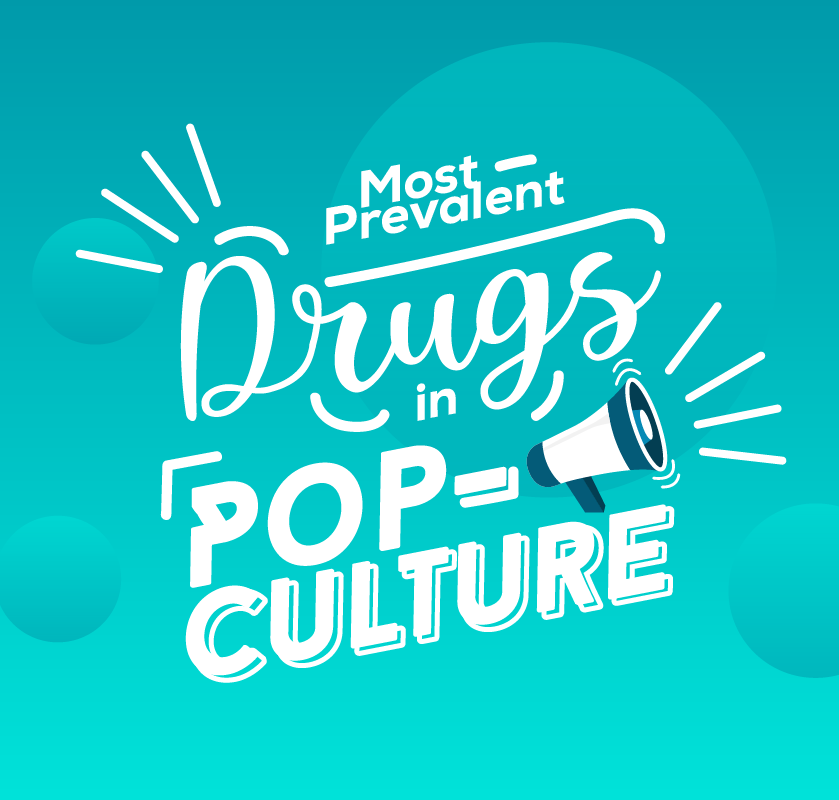
The human brain does not reach full maturity until the age of 25. Yet, more than half of all high school students experiment with illegal narcotics by the time they graduate, and as many as 70% are drinking alcohol by the age of 17. Even more alarming, many people who struggle with addiction during their teen years report trying drugs for the first time when they were only 12 or 13. Why are people experimenting with drugs and alcohol - and potentially damaging their brain development - at such young ages? Well, take a look around.
Popular teen-targeted television shows like Riverdale portray high school students drinking hard liquor as if it were iced tea, and it was only a few years ago that action figures of Breaking Bad's meth-cooking Walter White were being sold on toy store shelves alongside Barbies. It's not unusual for alcohol ads to appear during youth-targeted television series either, according to Georgetown University, and you can bet that alcohol manufacturers are fully of aware of who's watching during those pre-reserved timeslots.
Whether it's a fun meth-toting action figure or a gorgeous highschool girl doing a striptease at a bar (as portrayed in the teen series Riverdale), children are absorbing messages like these from an alarmingly young age. What's the message they're hearing? "Drugs and liquor are cool, man."
Young people aren't the only ones receiving a steady bombardment of alcohol and drugs in popular culture. Below we'll explore the cultural influence of each brand of narcotic and how it's being touted in the media.
Street names: Smack, H, Black Tar, Brown Sugar, Skag, Dope, Junk.
History: Opium derived from the poppy plant can be traced back to around 700 BC when it began to circulate through ancient Asian and European trade routes. What began as a "medicine to treat insomnia" became one of the first large-scale addiction epidemics on record.
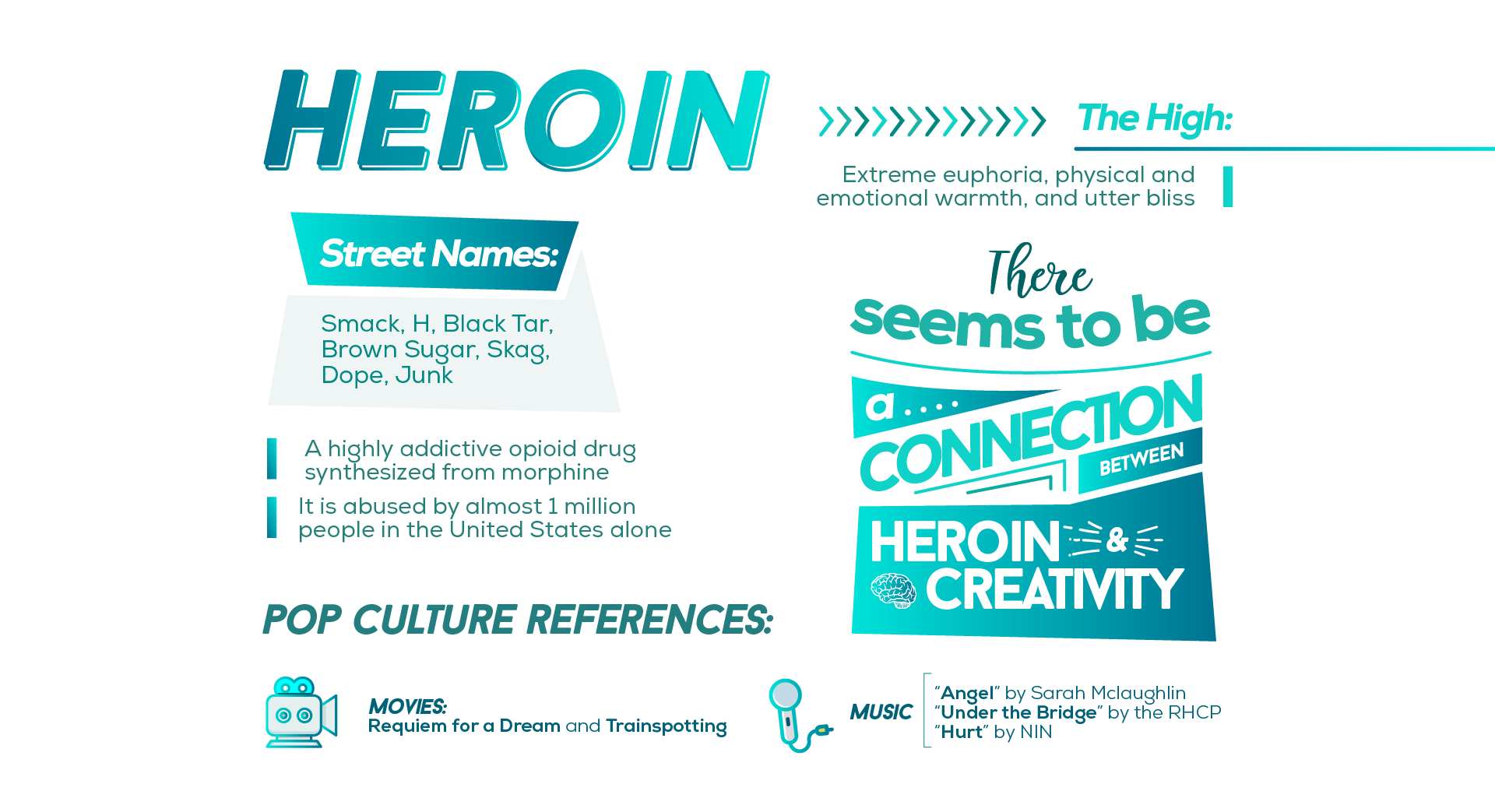
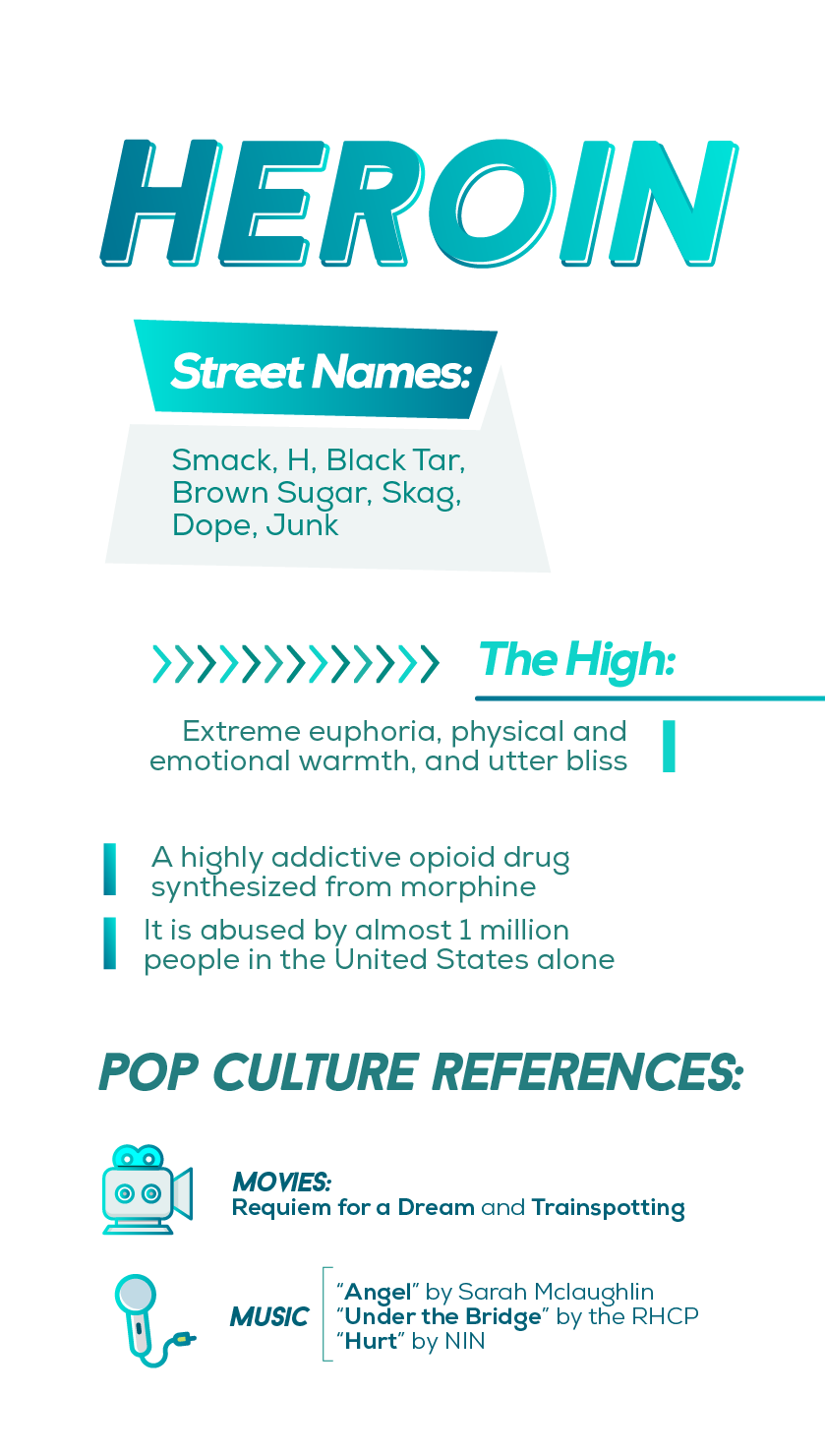
Fast forward to the 1800s; morphine was first extracted from opium, and a new world of pain management was discovered, along with new opportunities for addiction. In 1874, chemist C. R. Alder Wright synthesized heroin from morphine and doctors everywhere touted it as a "wonder drug" for everything from insomnia to the common cold and diarrhea. It didn't take long for the world to realize its dangers, however; in 1924 heroin was declared an illegal substance by congress.
Now, partly due to a rise in opioid prescriptions in the 1990s, heroin is abused by almost a million people in the United States alone.
Cultural influences: Heroin is famous for being dangerously addictive, an idea that is reflected in most conspicuous cultural references - movies like Requiem for a Dream and Trainspotting. Both of these films paint a picture of the nitty, gritty, borderline terrifying side of addiction.
On the other hand, there does seem to exist some connection between heroin and creativity, which is why it has become popular among jazz circles and art scenes. Jazz musician Charlie Parker openly attributed his genius to heroin, while painter Jean-Michel Basquiat admitted to consuming loads of heroin on a daily basis. Both artists died due to the complications of substance abuse.
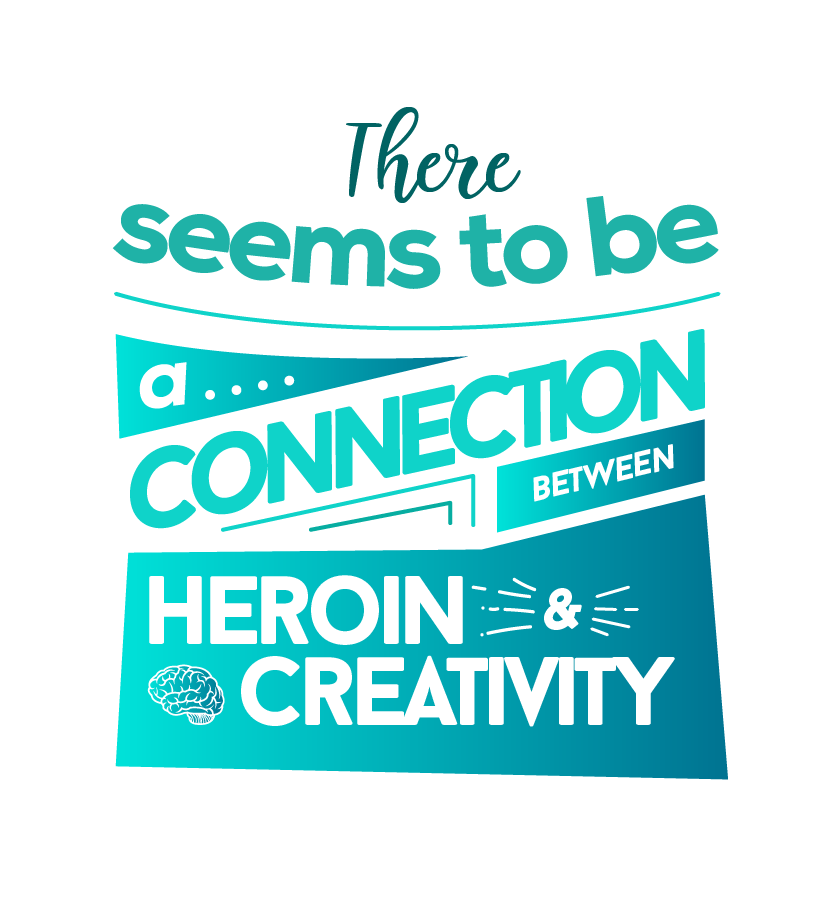
Of course, heroin also had a huge influence on the Seattle-based grunge rock scene of the 1990's, as demonstrated by groups like Nirvana and Alice in Chains. The New York Times dubbed Seattle of the 1990s as the hub of "espresso, beer and heroin", a statement that seems more than a little ironic considering Seattle's ongoing battle against the current opioid epidemic.
Pop culture references: Besides movies that illustrate heroin addiction, many popular mainstream songs have been written about it, if not in a positive light. "Angel" by Sarah Mclaughlin was about a heroin overdose, while "Hurt" by NIN and "Under the Bridge" by the Red Hot Chili Peppers both detailed the hardships of addiction. Overall, heroin addiction seems to be one of the last taboos left in pop culture; everyone admits that it's a bad idea.
"The needle tears a hole / The old familiar sting / Try to kill it all away / But I remember everything / What have I become / My sweetest friend / Everyone I know / Goes away in the end" -- "Hurt", Nine Inch Nails
Street names: Lean, Purple Drank, Sizzurp.
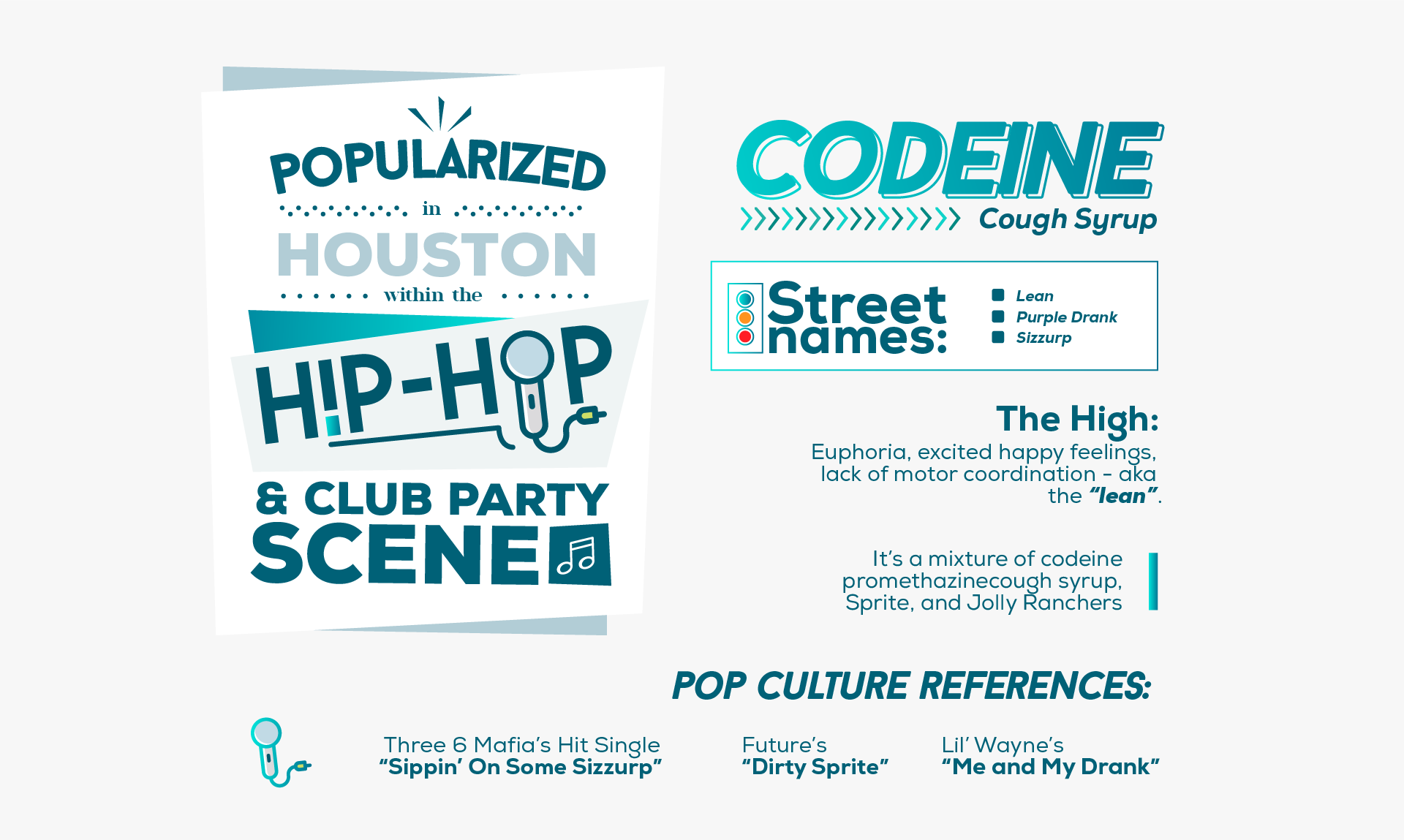
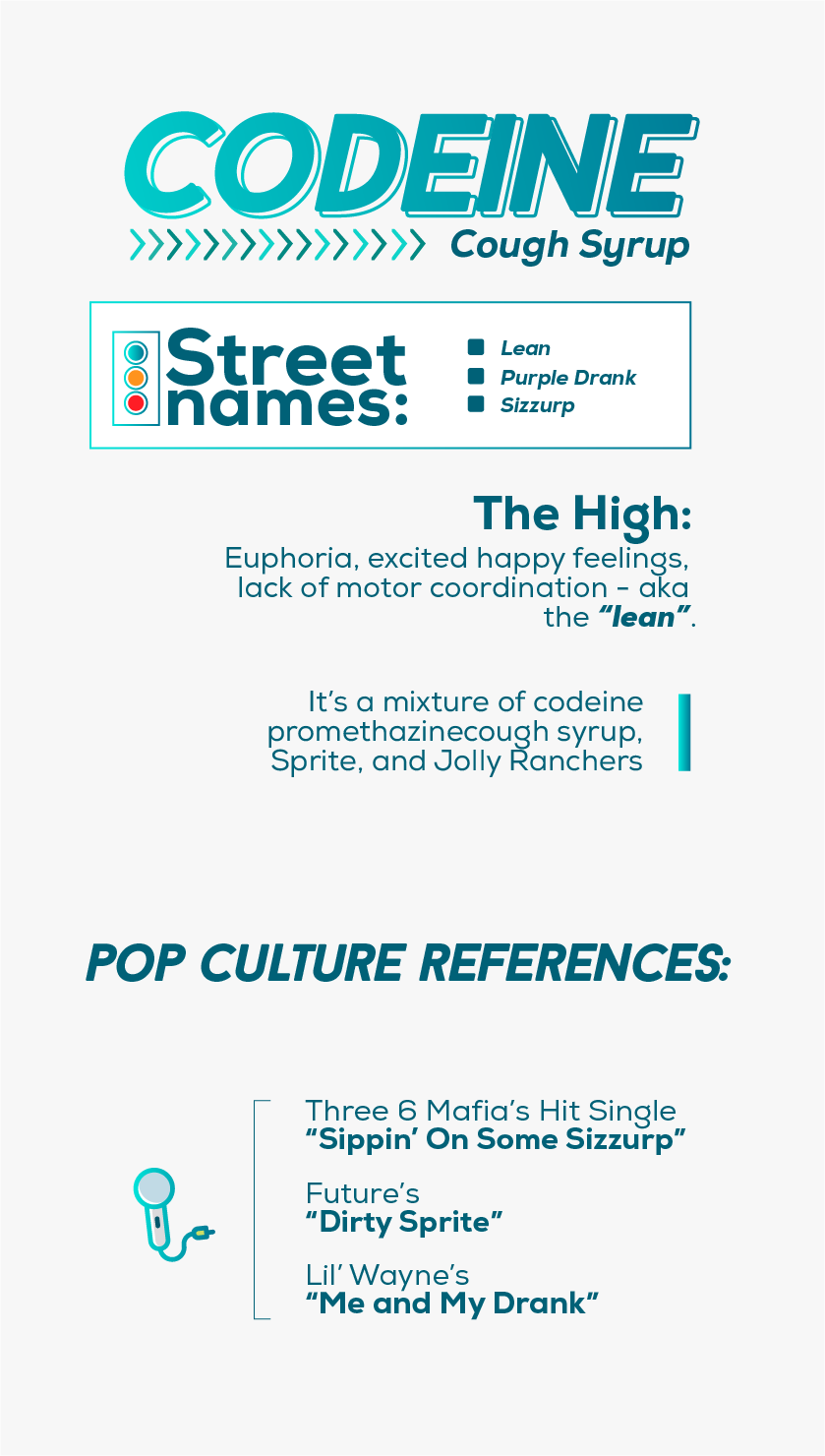
History: This codeine cough syrup concoction was first popularized in Houston, Texas within the hip-hop and club party scene. The mixture is made up of codeine promethazine cough syrup, Sprite, and Jolly Ranchers; it is known for its vibrant purple color. This is one drug in particular that can blame its popularity almost entirely on pop culture.
The sickly sweet purple "drank" first came out of obscurity when an artist named DJ Screw invented his own "chopped and screwed" style of hip-hop that reflected the slow, relaxed feel of a sizzurp high. When Three 6 Mafia released their hit single "Sippin' On Some Sizzurp" in 2000, lean hit the mainstream and was adopted by curious partygoers the world over.
Cultural influences: While hip-hop turned lean into a widespread party drug, many of the industry's artists are also cautionary tales. Lean overdoses became commonplace in Houston, bringing about the deaths of local artists like DJ Screw, Pimp C, and Big Moe. Later, world-renowned stars like Lil' Wayne began to publicly boast about their purp' sipping habits, a habit that almost left Lil' Wayne dead in 2013 when its extended use brought on multiple seizures. Although hip-hop culture brought on the lean drink craze, perhaps its disastrous effects on celebrities will also bring about its end.
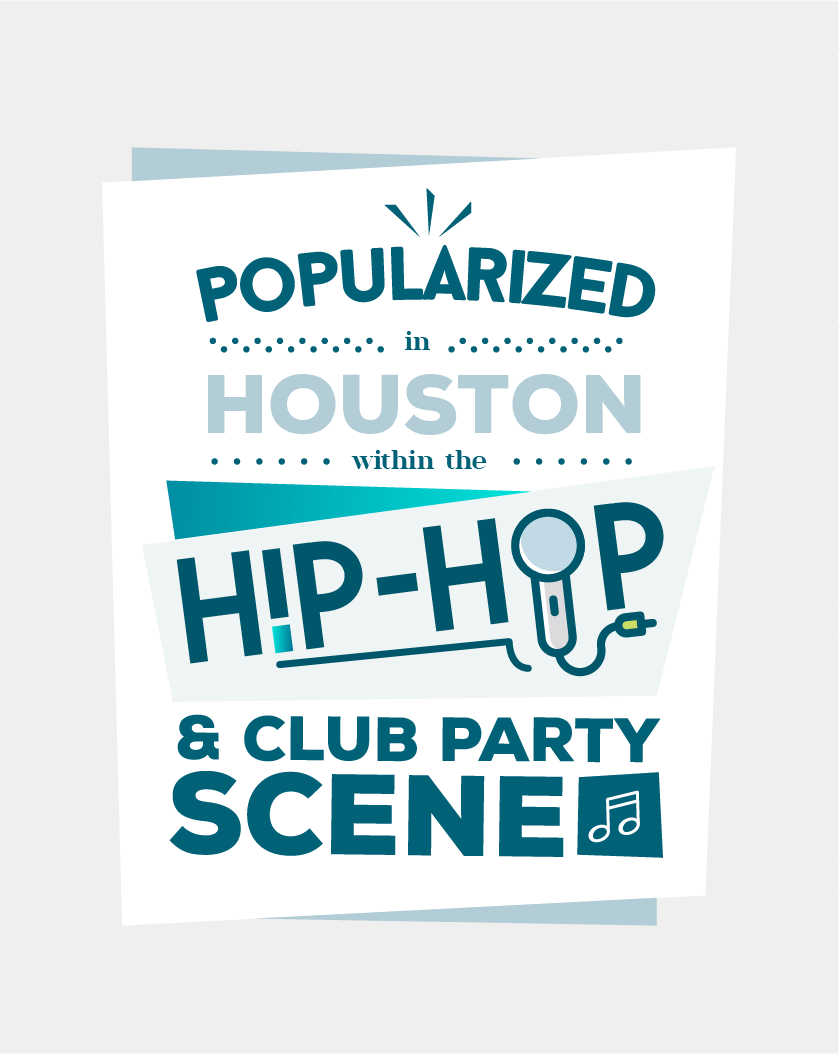
Pop culture references: The entire history of lean drink is about cultural influence, and there seems to be no end to the number of hip-hop songs that refer to it. After "Sippin' On Sizzurp" hit the top of the charts, a number of artists followed suit with songs like "Molly With That Lean" by SouljaBoy, "Dirty Sprite" by Future, and "Two Cups Stuffed" by Young Thug.
"Wait..now I can't feel my face / Up in the studio me and my drank, me and my drank, me and my drank / Will somebody please please double cup me / And everybody please please don't judge me." -- "Me and My Drank", Lil' Wayne
Street names: Weed, Mary Jane, Ganja, Green, Pot, Chronic.
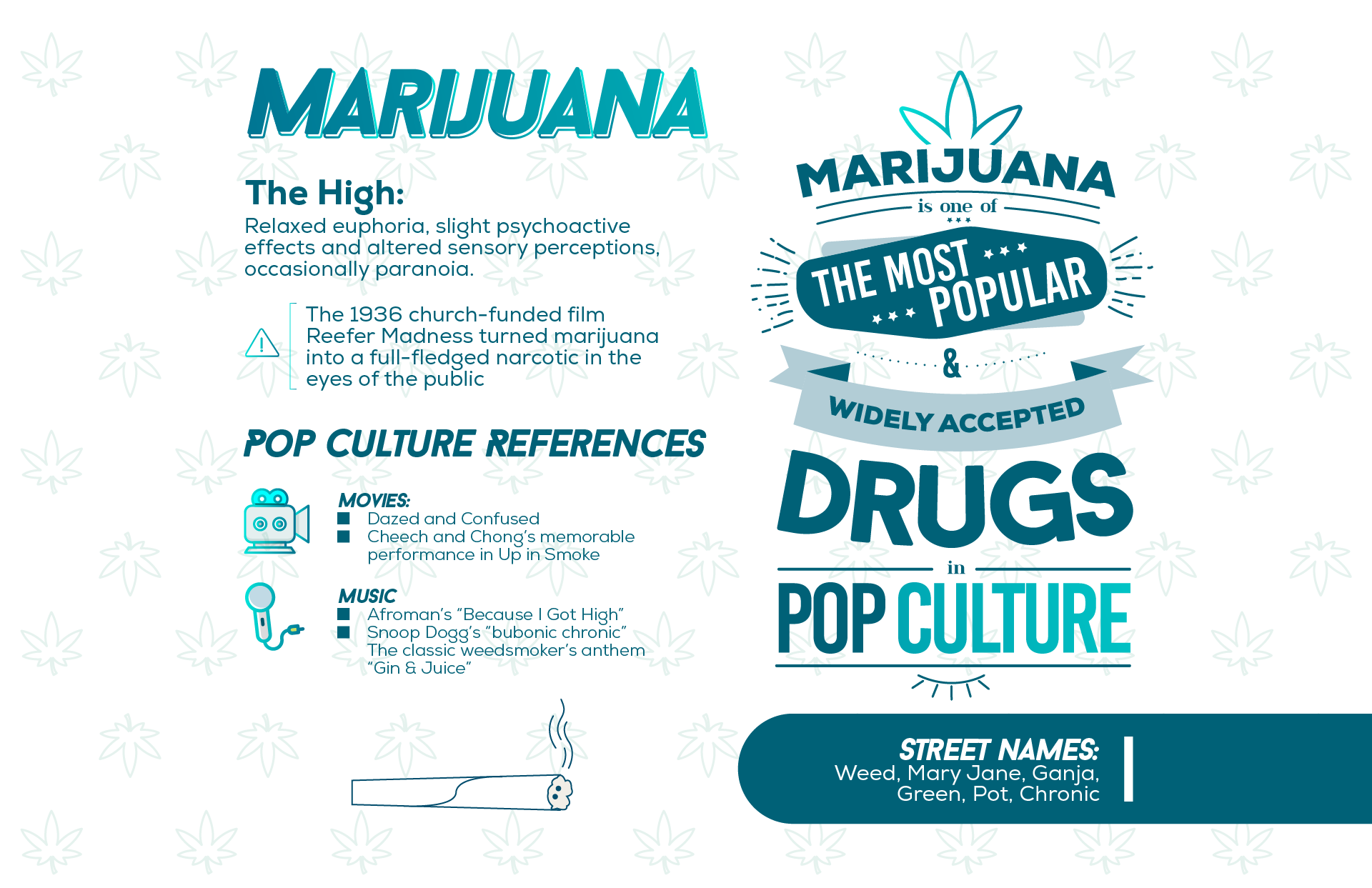
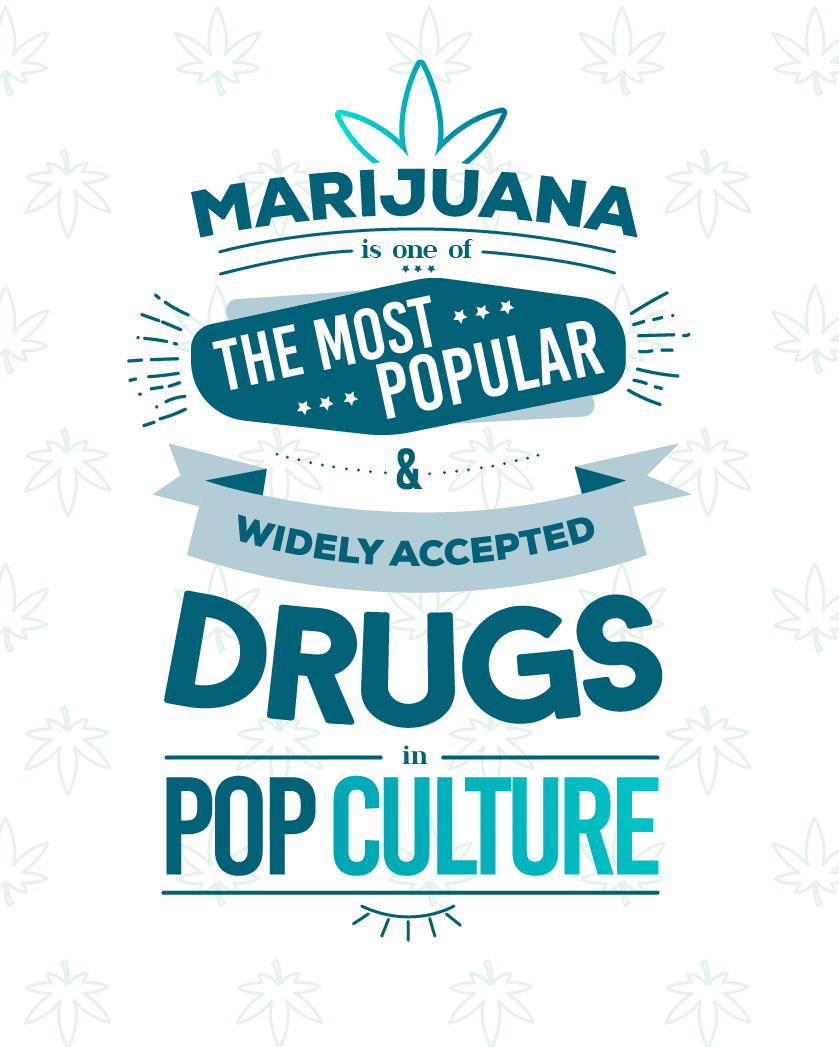
History: In ancient times, the cannabis plant was known more for its utility as hemp, a fibrous material that is created from the plant. Hemp was used to make textiles, although a few ancient Chinese emperors purportedly enjoyed the medicinal benefits of marijuana buds.
Weed was mostly considered medicinal for thousands of years - eaten, smoked, or mixed into liquids to soothe stomach ailments, earaches, and rheumatism. Even when marijuana first began to be outlawed for medicinal or recreational use in 1917, it was rarely used recreationally. Of course, making it illegal increased people's interest in the substance tenfold, and real weed-smoking started to catch on in the 1920s.
Fast forward to 1936, and the church-funded film Reefer Madness turned marijuana into a full-fledged narcotic in the eyes of the public. A few years later, it was completely banned for medicinal use across the United States. Now, cannabis as a remedy for pain and nausea is once again becoming more popular (and more legal) across the country.
Cultural influences: Although marijuana as a recreational drug wasn't well-known in the United States until Reefer Madness caused fear and terror among parents everywhere, it began to have real cultural influence in the 1950s and 60s. Its psychoactive effects made it wildly popular within the hippie movement, and cannabis was forever linked with the flower children and beatniks. Combine that with Bob Marley's famous love for weed and its association with the reggae lifestyle, and you have a real cult following on your hands. To this day, cannabis culture is alive and well, with its own etiquette, language, art, music, and movies.
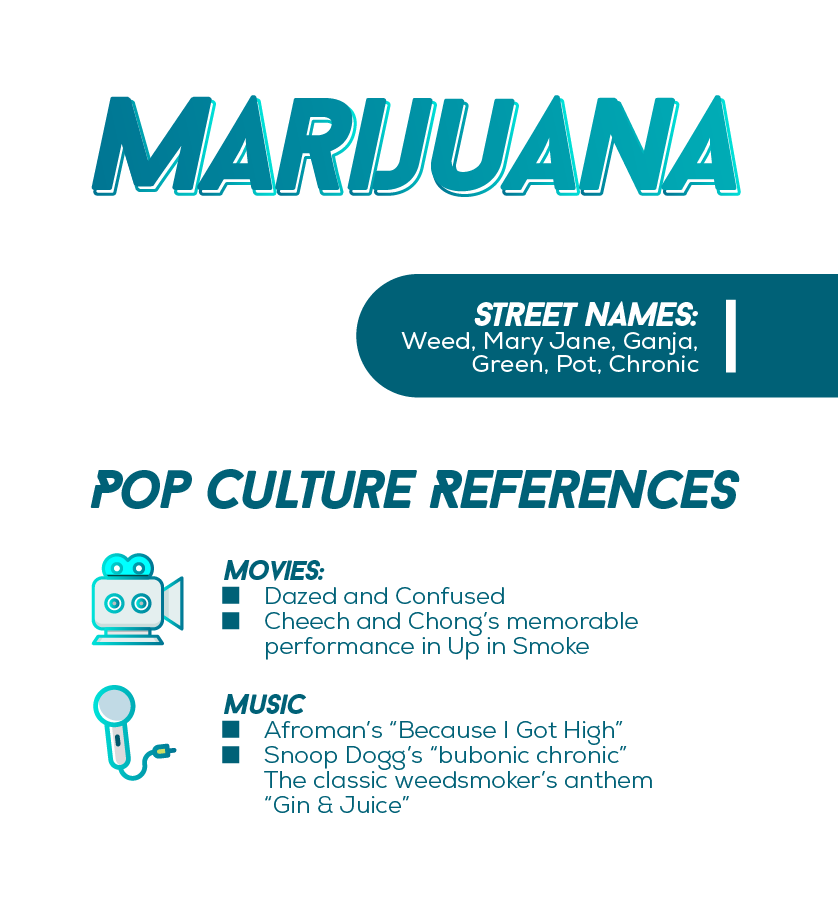
Pop culture references: Where to begin? Stoner films have been a thing since Highschool Confidential! came out in 1958 and the trend continued with classics such as Fast Times at Ridgemont High, Dazed and Confused, and who could forget Cheech and Chong's memorable performance in Up in Smoke?
CHONG: "You wanna get high man?"
CHEECH: "Does Howdy Doody got wooden balls man?"
Music is also full of pot references, such as Afroman's catchy "Because I Got High" track or Snoop Dogg's references to "bubonic chronic" in the classic weedsmoker's anthem "Gin & Juice". In fact, it may be safe to say that marijuana is one of the most popular and widely accepted drugs in pop culture to date.
"My homey Dr. Dre came through with a gang of Tanqueray / And a fat ass J, of some bubonic chronic that made me choke / Shit, this ain't no joke / I had to back up off of it and sit my cup down / Tanqueray and chronic, yeah I'm fucked up now" -- "Gin & Juice", Snoop Dogg
Street names: Coke, Blow, Powder, Snow, Crack.
History: The coca plant has ancient roots as a mild natural stimulant used ritually by the indigenous cultures of South America, namely tribes surrounding the Amazon rainforest and Andes Mountains. The leaves were roasted and chewed, much like chewing tobacco; the ritual is still practiced legally by the remnants of those ancient cultures.
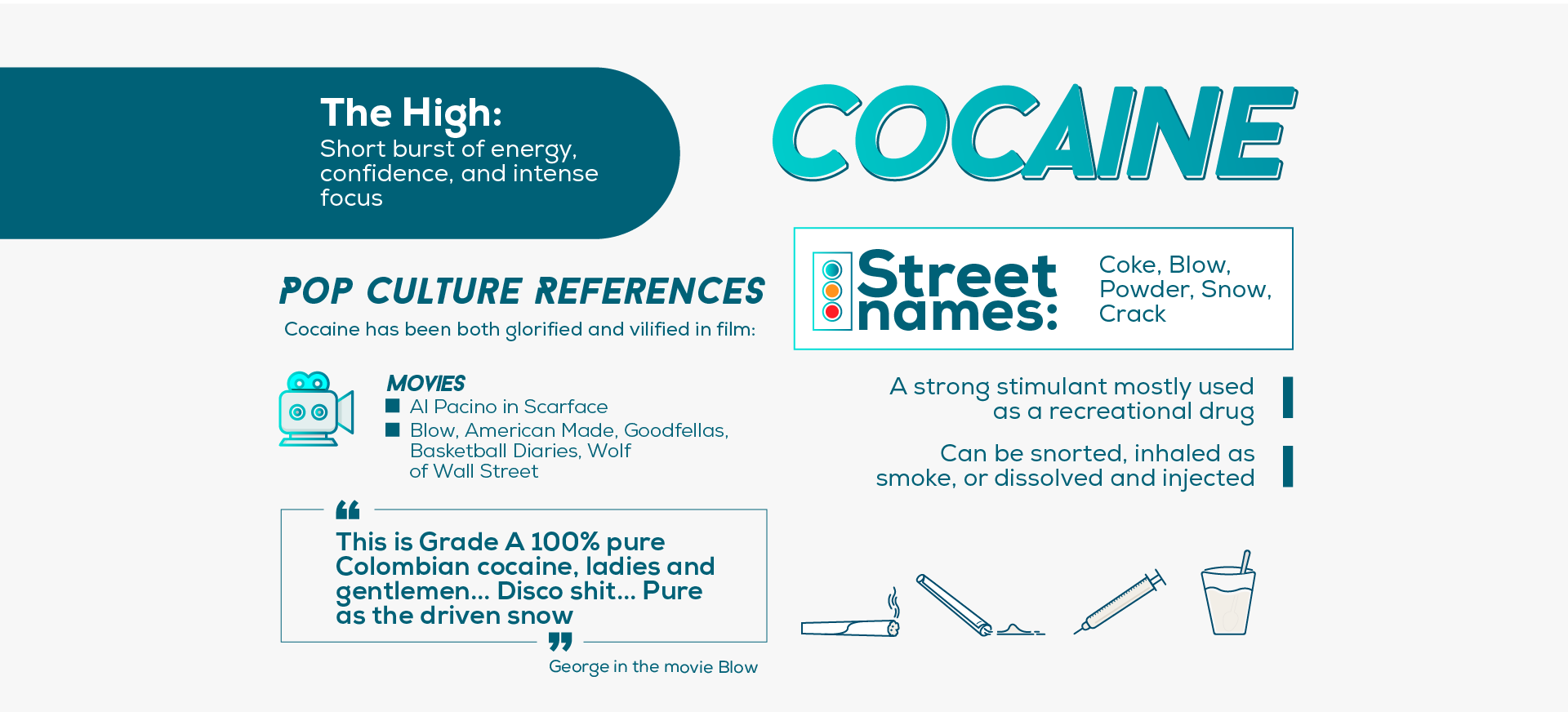
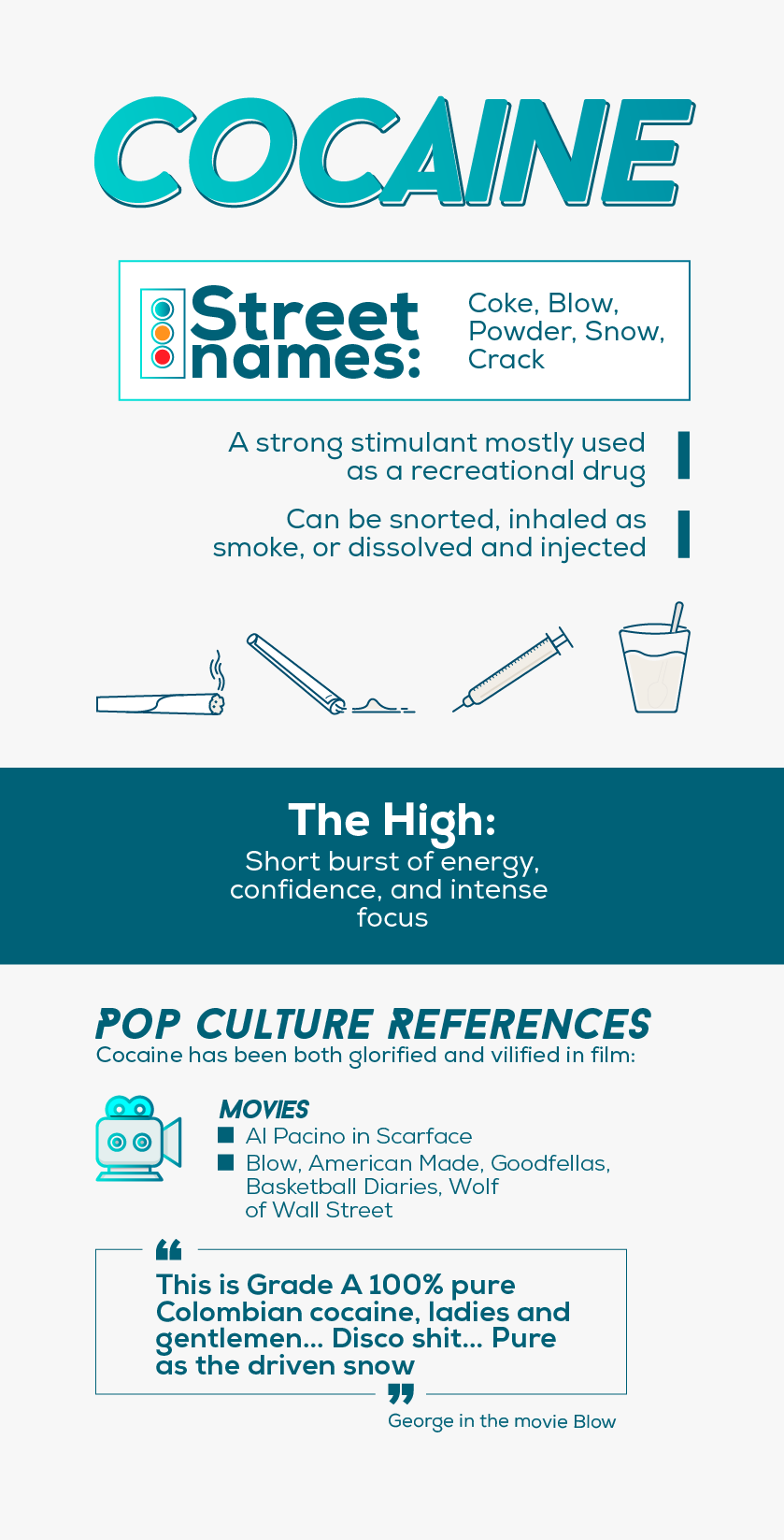
Of course, 19th-century chemists were keen to start extracting the active ingredients from the coca leaf when they noticed its stimulant properties, and cocaine was born in the form of a fine white powder. Doctors tried using it as an anesthetic because of its numbing properties, but the strong substance caused overdose too often to be used as a viable medical drug.
Then, American pharmacist John Stith Pemberton concocted a carbonated beverage containing pure cocaine, resulting in a nation addicted to Coca-Cola. Although the formula was changed a few years later, the Coca-Cola sensation was here to stay, and cocaine's pleasurable effects became widely known.
Cocaine was outlawed in any form in 1914, but it was regularly used for recreational purposes in certain crowds. Then in the late 1970s, cocaine usage suddenly spiked to include over 5 million users nationwide. It was cocaine that brought America's War on Drugs into the limelight, since its popularity led to thousands of drug arrests.
Cultural influences: Cocaine had several simultaneous and powerful levels of influence on American culture, especially during the 1980s and '90s. On one side, cocaine came on hard into the glitzy Hollywood lifestyle of the West Coast. It may have begun with free samples passed out by cartel and dealer contacts at ritzy parties, but it soon infused the very fabric of daily life in Los Angeles. From executives and producers to movie stars, "everybody was doing it," according to manager to the stars Jeff Wald.
On the other end of the country, America's first crack houses were opening up in every inner-city neighborhood, and the crack epidemic was just taking off. Of course, it was the dirty, squalid culture of inner-city crack addiction that further fueled the nation's War on Drugs because, let's face it, it's easier to blame the poor people.
The War on Drugs brought on an entirely different - and much more political - level of cultural significance to daily life. Inner-city neighborhoods were targeted for nationwide drug busts that ended in thousands of minority youth facing sudden and serious jail time. This phenomenon resulted in an unforeseen result - a "fuck the police" attitude that continues to pervade inner-city and hip-hop culture. Resentment between minorities and the authority figures of the nation only continues to grow and, unfortunately, the War on Drugs persists. Instead of inner-city youth receiving the help they need, millions of young minorities continue to populate the nation's jail cells for drug-related crimes.
Pop culture references: Despite its dark and dangerous past, cocaine was never lost on pop culture. In fact, it seems that the danger and darkness are what make it so seductive. Let's all take a moment to reflect on Al Pacino in Scarface, bathing in mountains of coke and emerging minutes later with that oh-so-iconic line, "Say hello to me little friend!" Cocaine pop culture at its finest. Blow, American Made, Goodfellas, Basketball Diaries, Wolf of Wall Street - all movies that either glorify or vilify cocaine culture. And let's not forget the dozen or so movies and series that center around the kingpin of all kingpins - Pablo Escobar.
Music, art, and literature are no exception. Some of Stephen King's most famous works were allegedly born out of long nights stimulated by powder-dusted dollar bills. Eric Clapton didn't even attempt to be subtle and named one of his most popular songs after the drug. More recently, Miley Cyrus sang about girls "trying to get a line in the bathroom". It would appear that despite the havoc wrought, America's love affair with cocaine is far from over.
"This is Grade A 100% pure Colombian cocaine, ladies and gentlemen... Disco shit... Pure as the driven snow." --George in the movie Blow.
Street names: Ecstasy, E, X, Molly, Disco Biscuits
History: Although MDMA was first developed by a German pharmaceutical company in 1913, it was never thoroughly tested or used before the 1950s, when military organizations began testing it as a truth serum and psychological weapon. The military could find no reliable use for MDMA, but psychiatrists soon became fascinated with the drug, prescribing it to patients as a method to facilitate the therapy process and open up communication channels.
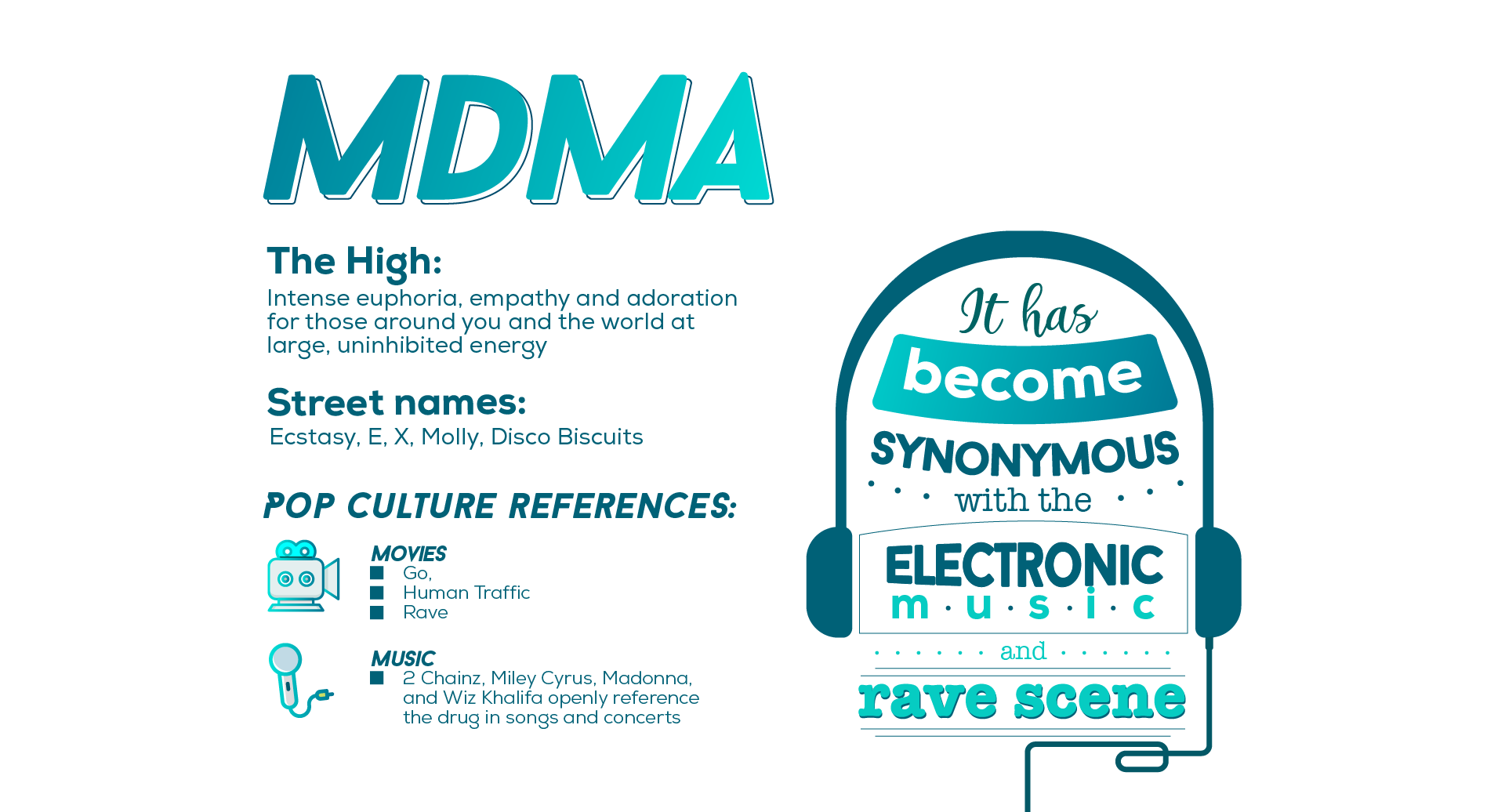
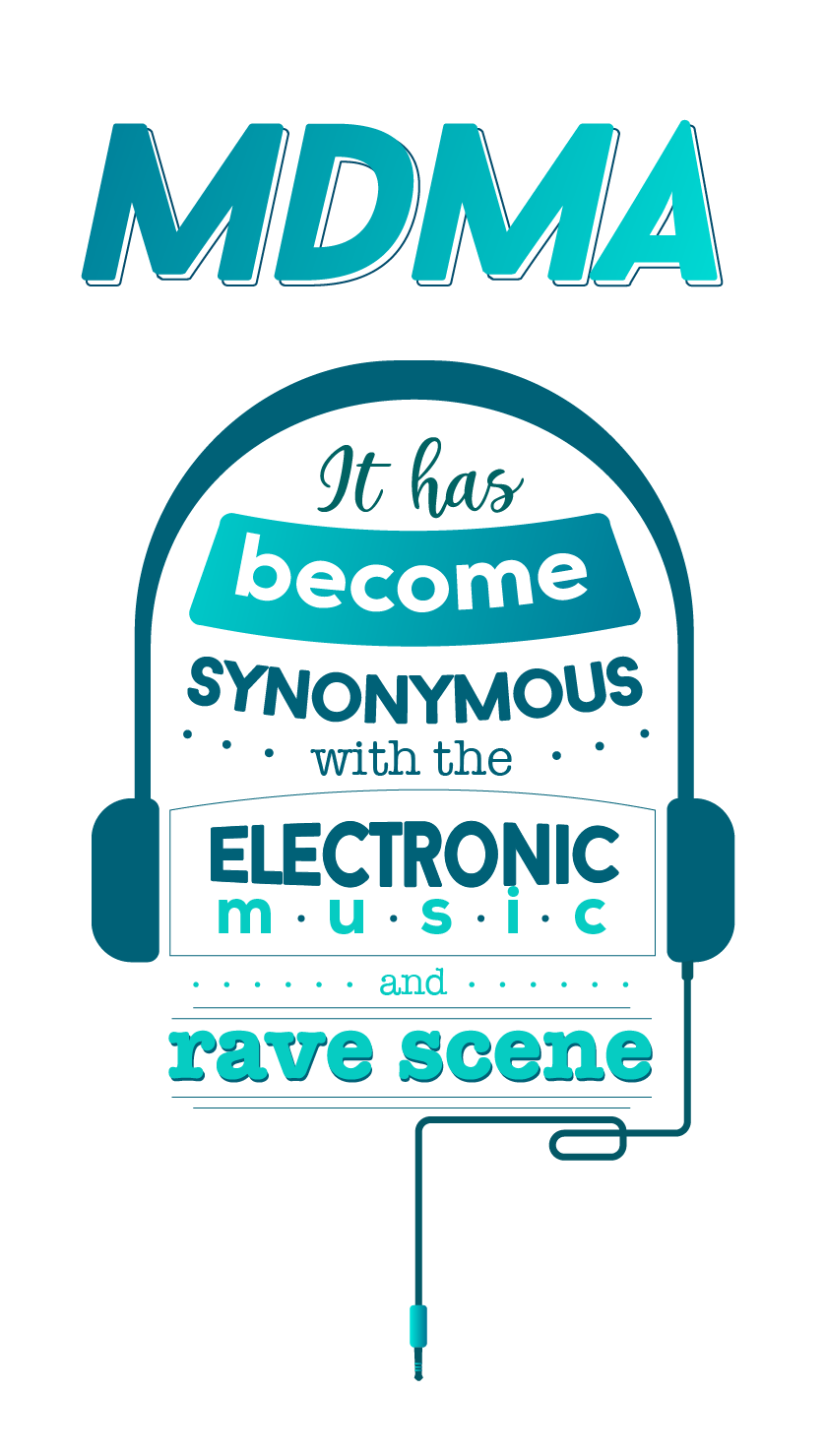
It wasn't until the 1980s that the common people discovered the seductive psychoactive and euphoric pleasures of ecstacy. The drug became so popular as a party drug that it was criminalized by the DEA in 1985.
The growing popularity of dance festivals and rave culture only propagated the illegal use of ecstasy; now MDMA has become synonymous with the electronic music and rave scene.
Cultural influences: It's not clear if ecstasy gave birth to rave culture or vice versa, but either way, the two have been synergetic since their birth in 1980s Britain. The first raves were held in a hippie commune on a Spanish island called Ibiza in the mid-1980s. When London-based DJ Paul Oakenfold experienced one such all-night party under the influence of ecstacy and acid house music (a precursor to the electronic genre), he was forever changed. Determined to prolong the bliss he experienced in Ibiza, he and three friends spearheaded the rave movement in London, popularizing the use of MDMA as they went along. From there, rave culture spread like wildfire across the world, and the use of ecstasy was integral to the experience.
Electronic music, dance raves, and music festivals were all influenced (if not born) by this movement, and it is a phenomenon that continues to grow and change today.
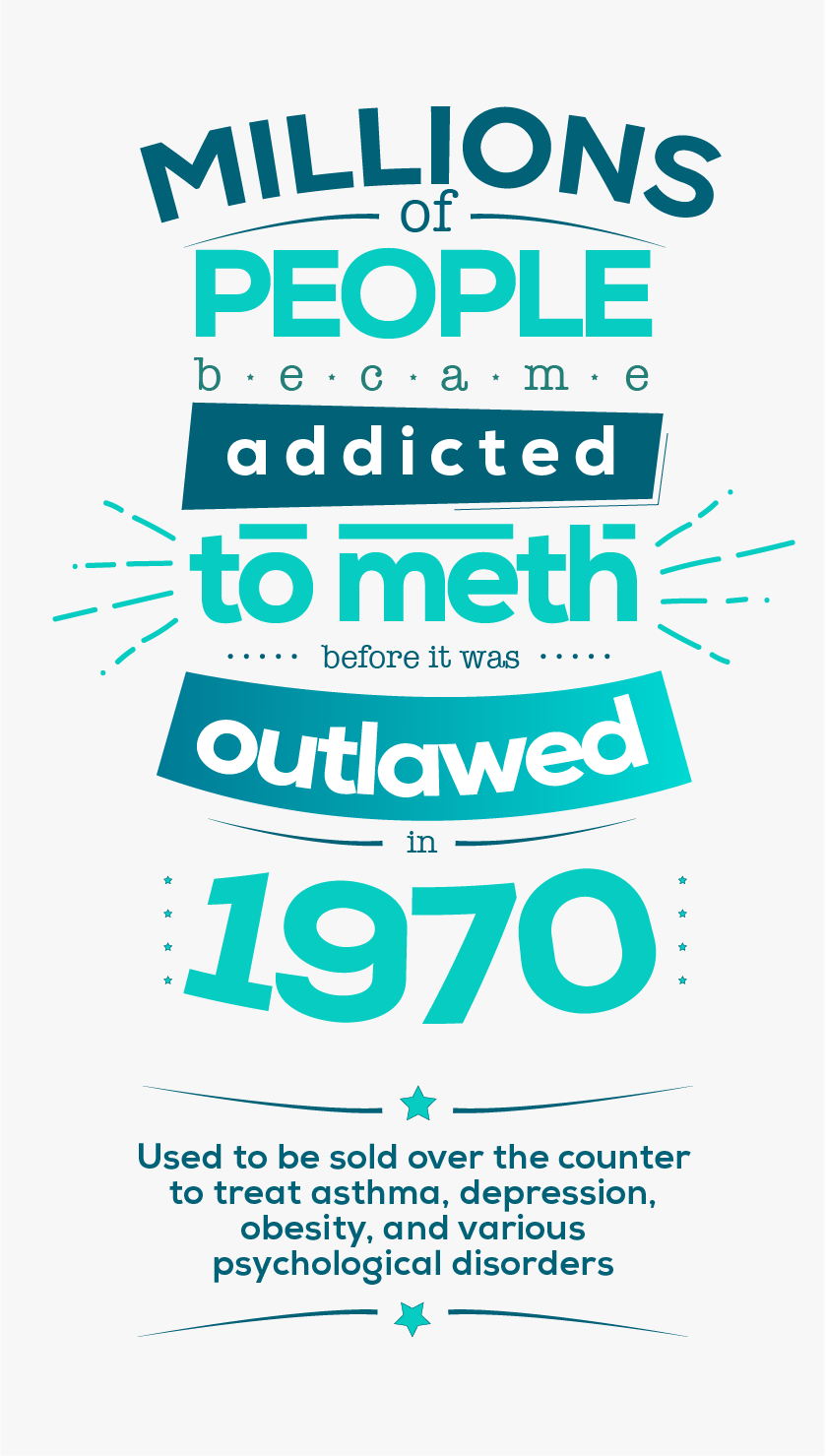
Pop culture references: Acid house and electronic music are the obvious love children of an ecstacy-influenced culture. However, somewhere in the late '80s, the rest of pop culture caught on to the movement. A rash of unremarkable movies followed, such as Go, Human Traffic, and Rave, in which D-list actors spout such gems as, "Present is gone. Fantasy is a part of reality. We take the breaks off. We're thinking clearly yet not thinking at all. This feels right. We stop trying to control things. Warm rush of chemicals through us. We fluctuate. Is this brain damage?" (Human Traffic)
Then there's the more recent rebirth of MDMA, now dubbed Molly in its allegedly purer form. Molly took the millennial generation by storm, entering the mainstream club scene with artists like 2 Chainz, Miley Cyrus, Madonna, and Wiz Khalifa openly referencing the drug in songs and concerts. Madonna made headlines when she asked the crowds at the 2012 Ultra Music Festival, "How many people in this crowd have seen molly?"
"Palms rise to the universe / As we moonshine and Molly / Feel the warmth we'll never die / We're like diamonds in the sky." --"Diamonds", Rihanna
Street names: Speed, Crank, Tweek, Crystal, Ice.
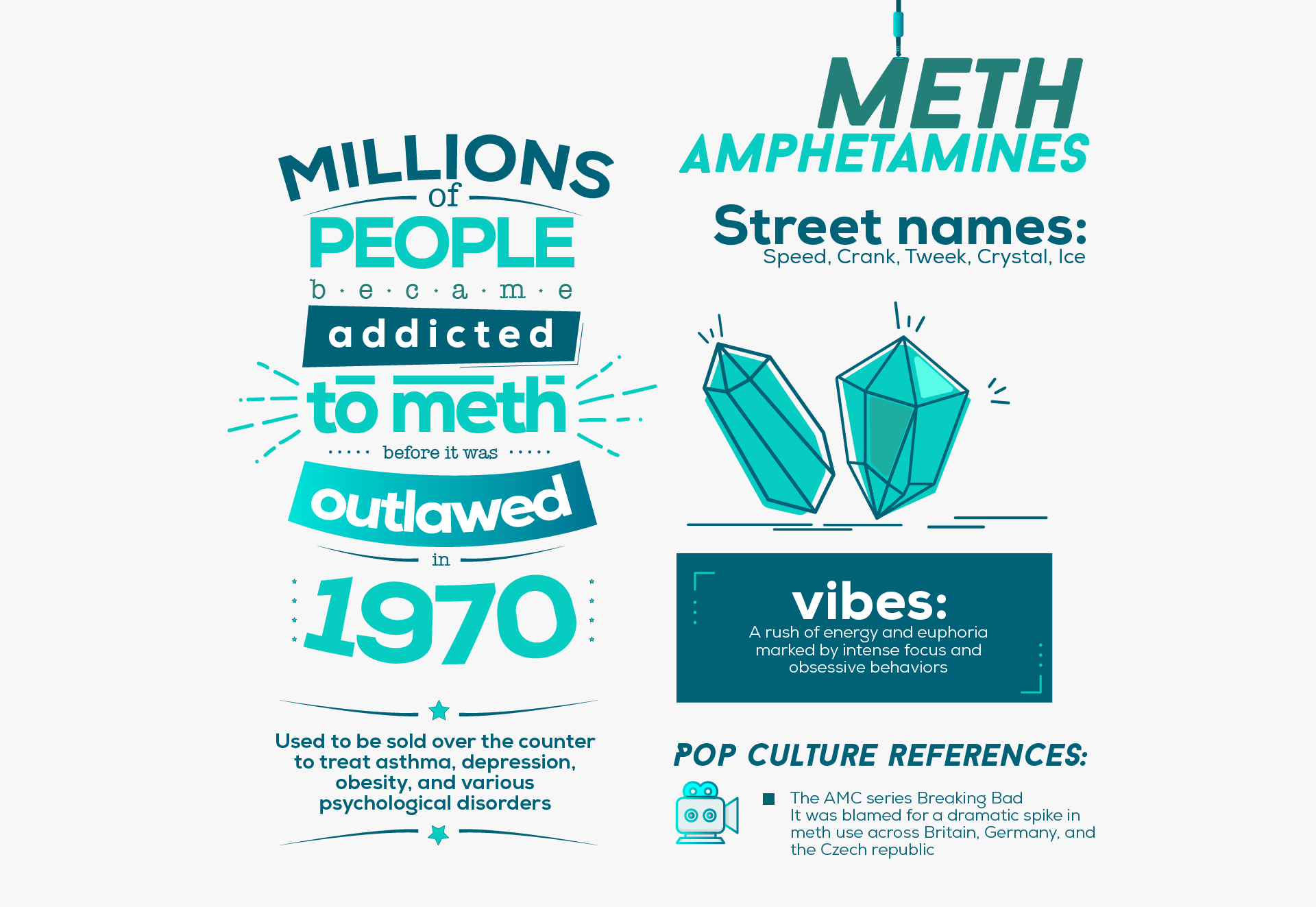
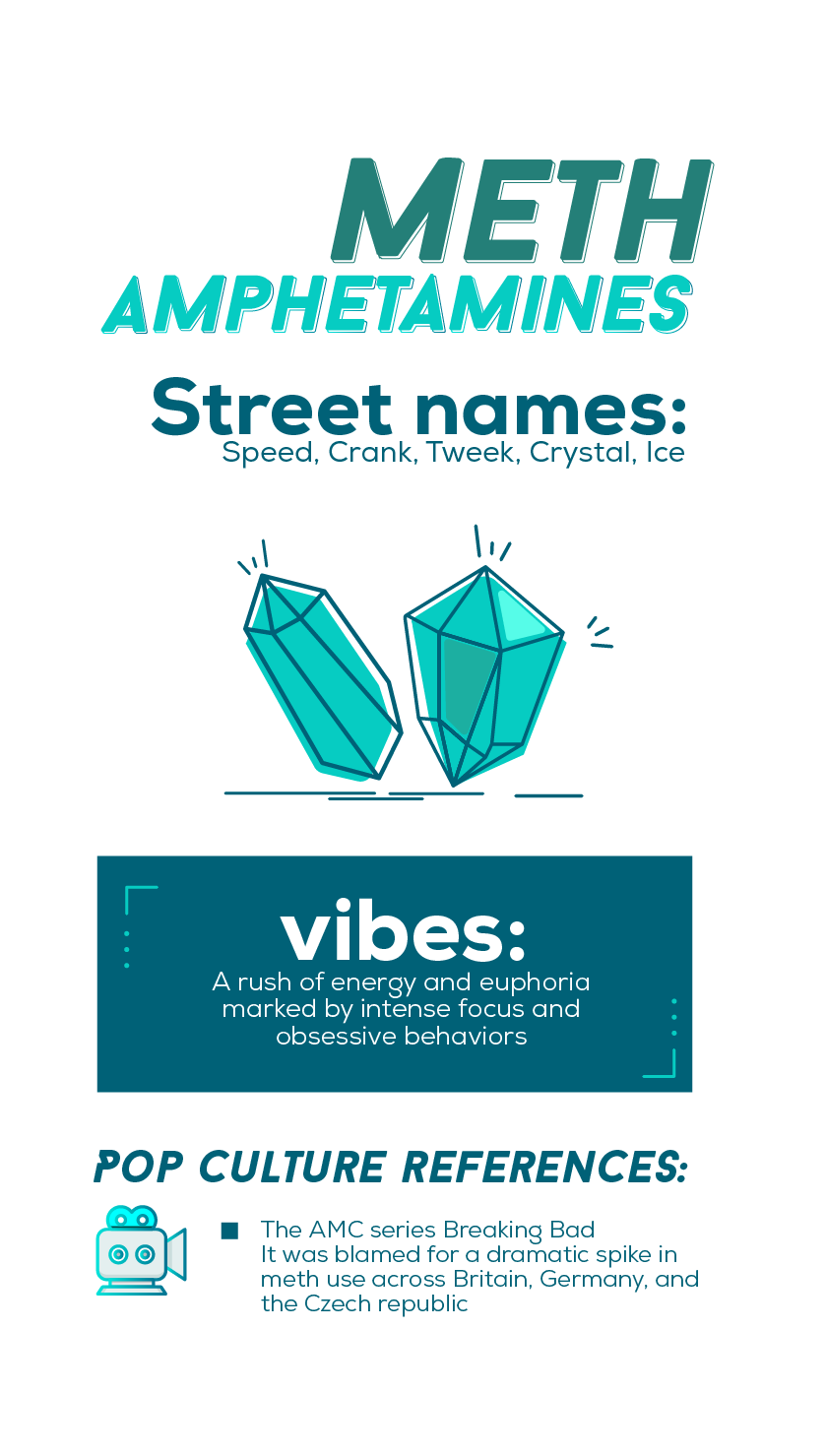
History: Meth has been around for a surprisingly long time. It was first invented from ephedra extracts by a Japanese chemist in 1893. Like most other illicit drugs, doctors and scientists originally tried to find a medical use for it, such as a treatment for narcolepsy, asthma, or obesity. Once the military got ahold of meth, it was used as a stimulant to keep soldiers fighting days-long campaigns without sleep. Of course, this usage of the drug made it more widely known to the general public, and meth abuse became widespread across the world.
Despite its addictive nature, the dangers of meth were not recognized throughout the 1950s and '60s, when it was prescribed as a diet drug and used by everyone from college students to truck drivers as a stimulant. Meth was not outlawed until 1970, but by then, over a million people in the United States were using it. Since then, its use has been hedged into more rural or underprivileged areas, where access to stimulants like cocaine is too difficult or expensive.
Cultural influences: Although many controlled substances were used at some point in attempted pharmaceutical applications, methamphetamines were by far the most common and commercially marketed throughout the mid-20th century. For years, an almost-pure form of meth was sold in inhalers and tablets over-the-counter to treat asthma, depression, obesity, and various psychological disorders. Millions of people became addicted to meth before it was outlawed in 1970, and the country has never recovered.
Today, partly due to the devastating effects of meth abuse and partly due to pop culture, meth has a dirty, slummy reputation as 'poor man's coke', or a 'redneck's cocaine' because of its association with underprivileged rural populations. Therefore it's rather surprising that recent pop culture has had such a significant impact on the public perspective of meth. Read more in the section below.
Pop culture references: There are quite a few pop culture references that may have been influential in meth culture, but one in particular has been revolutionary. The AMC series Breaking Bad brought the trashy, obscure world of meth cooking, abuse, and dealing into a glaring spotlight. Although the program did not put a positive light on the drug, it did seem to glamorize the drug trade, according to law enforcement.
The effects were mixed. Across Europe, officials at the European Monitoring Centre for Drugs and Drug Addiction blamed the TV program for a dramatic spike in meth use across Britain, Germany, and the Czech republic. Breaking Bad became so ubiquitous that toy manufacturers began to make Walter White figurines (complete with a little bag full of 'Blue Sky') and stack them onto store shelves alongside Barbies and baby dolls. It would seem that Breaking Bad brought meth into the mainstream; after all, it doesn't get much more mainstream than Toys R Us.
"Let's get something straight. This – the chemistry – is my realm. I am in charge of the cooking. Out there on the street, you deal with that." – Walter White in Breaking Bad.
Street names: Uppers, Study buddies, Addys, Pep pills.
History: Not surprisingly, amphetamine - the active ingredient in prescription stimulants - was synthesized at around the same time as meth, and from the same base ingredients. Both are stimulants of the nootropic category, although Adderall is much less potent and less addictive than its trailer-park associated counterpart. During the early 1900s, amphetamine was used in the same ways as methamphetamines, to treat asthma, depression, and obesity. It became highly popular as a stimulant during the 1950s, at which point college students across the country discovered 'study buddies' as a way to focus and stay up late studying.
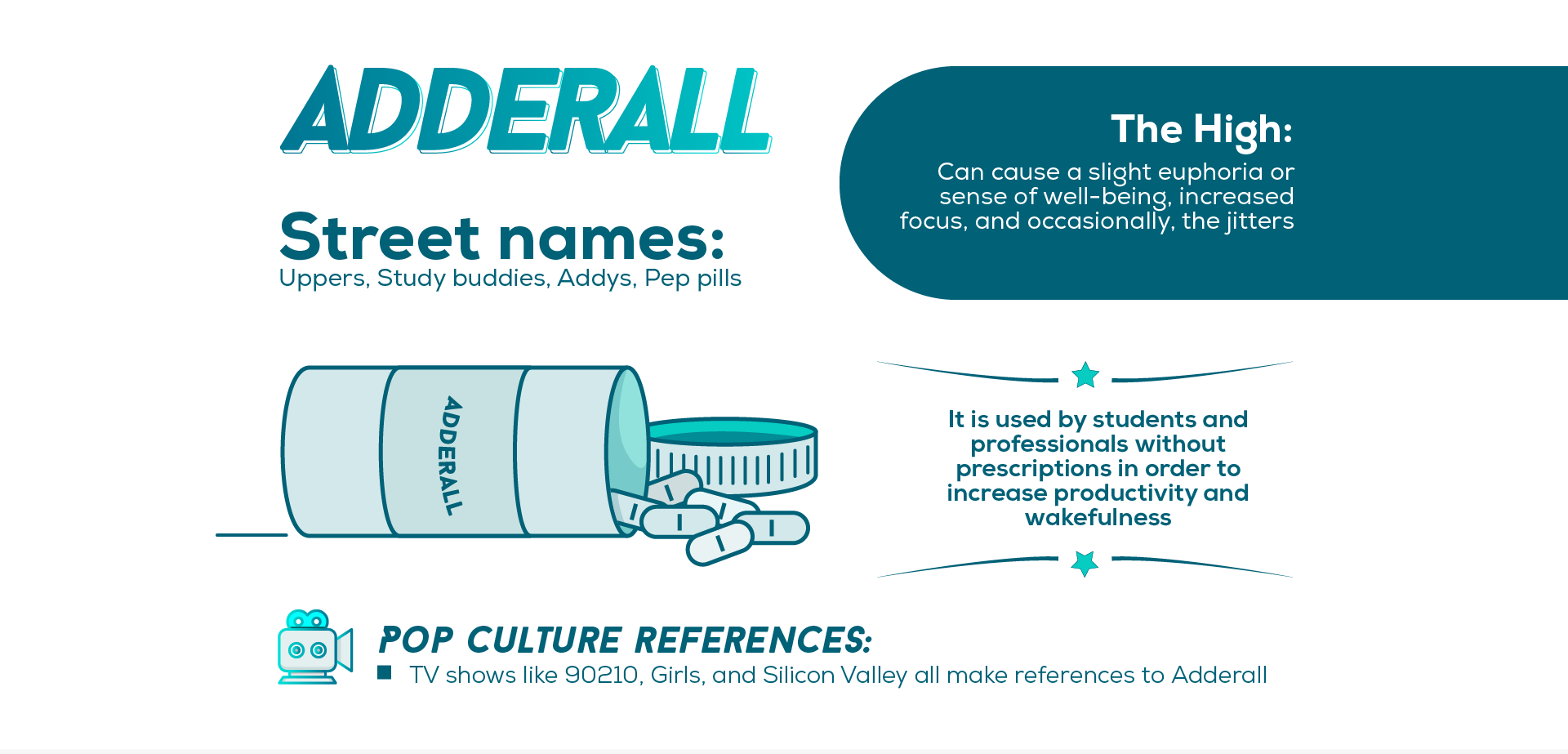
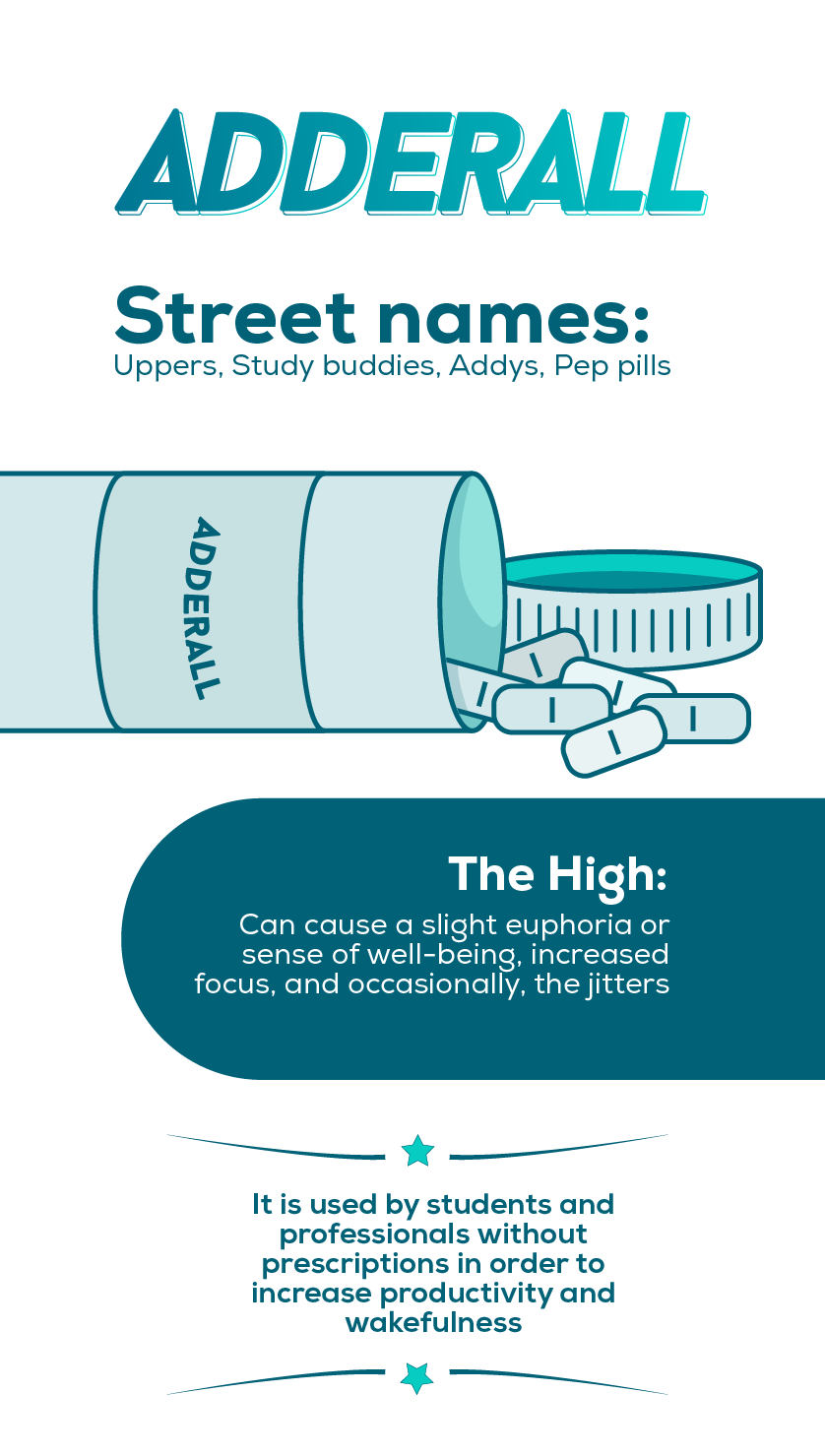
In the 1980s, doctors began to prescribe Adderall to treat newly discovered attention-deficit disorders like ADHD, furthering its reputation as a helpful study aid. Today, it is used more than ever by students and professionals without prescriptions in order to increase productivity and wakefulness. The problem is, even though Adderall is much less potent than illegal stimulants, it is still addictive, and abuse of prescription stimulants has been linked to other more dangerous types of drug abuse.
Cultural influences: Amphetamine has always been a white-collar class of 'smart drug', a socially acceptable form of drug abuse that people could justify due to its apparently positive outcomes. From the military to Hollywood directors, modern history is filled with examples of authority figures handing out prescription stimulants in order to increase productivity and stamina among employees.
Of course, Adderall has also been an influence among party crowds. After all, many college-age students rationalize that if it can make you stay up all night studying, it can also be used to stay up partying till dawn. This rationality quickly became part of nightclub, music, and rave cultures, where users mix Adderall with other substances for a long-lasting buzz and never-ending stamina to dance and engage in sexual activities. Because of its innocuous reputation, Adderall is often mixed with alcohol and other drugs, sometimes with disastrous effects.
Pop culture references: Adderall makes its appearance regularly in TV shows, movies, books, and music. Since the drug is so commonly used in mainstream society, it has no shock value and often goes relatively unnoticed in pop culture, but here are a few more memorable references:
The book The Adderall Diaries by Stephen Elliot documents one man's plight with Adderall addiction and the mess he makes of his life. TV shows like 90210, Girls, and Silicon Valley all make references to Adderall and touch on its potential dangers, while hip-hop artist Danny Brown talks openly about his use of the drug to increase creativity and productivity. In fact, Brown released a song called "Adderall Admiral" in 2011 that describes his Adderall-fueled writing process like so, "Eating on an Adderall, wash it down with alcohol / Writing holy mackerel, actual or factual".
More recently, Netflix released a documentary called Take Your Pills that chronicles the frequent use of Adderall by students, professionals, and athletes.
"When I was in college people did drugs to check out, and now they do drugs to check in," Anjan Chatterjee, the chair of neurology at the University of Pennsylvania, as stated in Take Your Pills.
Street names: Percs, C, Oxycet, Hillbilly Heroin
History: Percocet is a mixture of the opioid oxycodone and acetaminophen (Tylenol) that was developed in the 1970s. Since opioids have been abused since forever, doctors were rightly reticent to over-prescribe drugs like Percocet when they first emerged; however, studies and campaigns that were funded by the pharmaceutical industry began to justify and encourage good pain management, namely the prescription of narcotic painkillers for chronic pain. Thus the first wave of the modern-day opioid epidemic began.
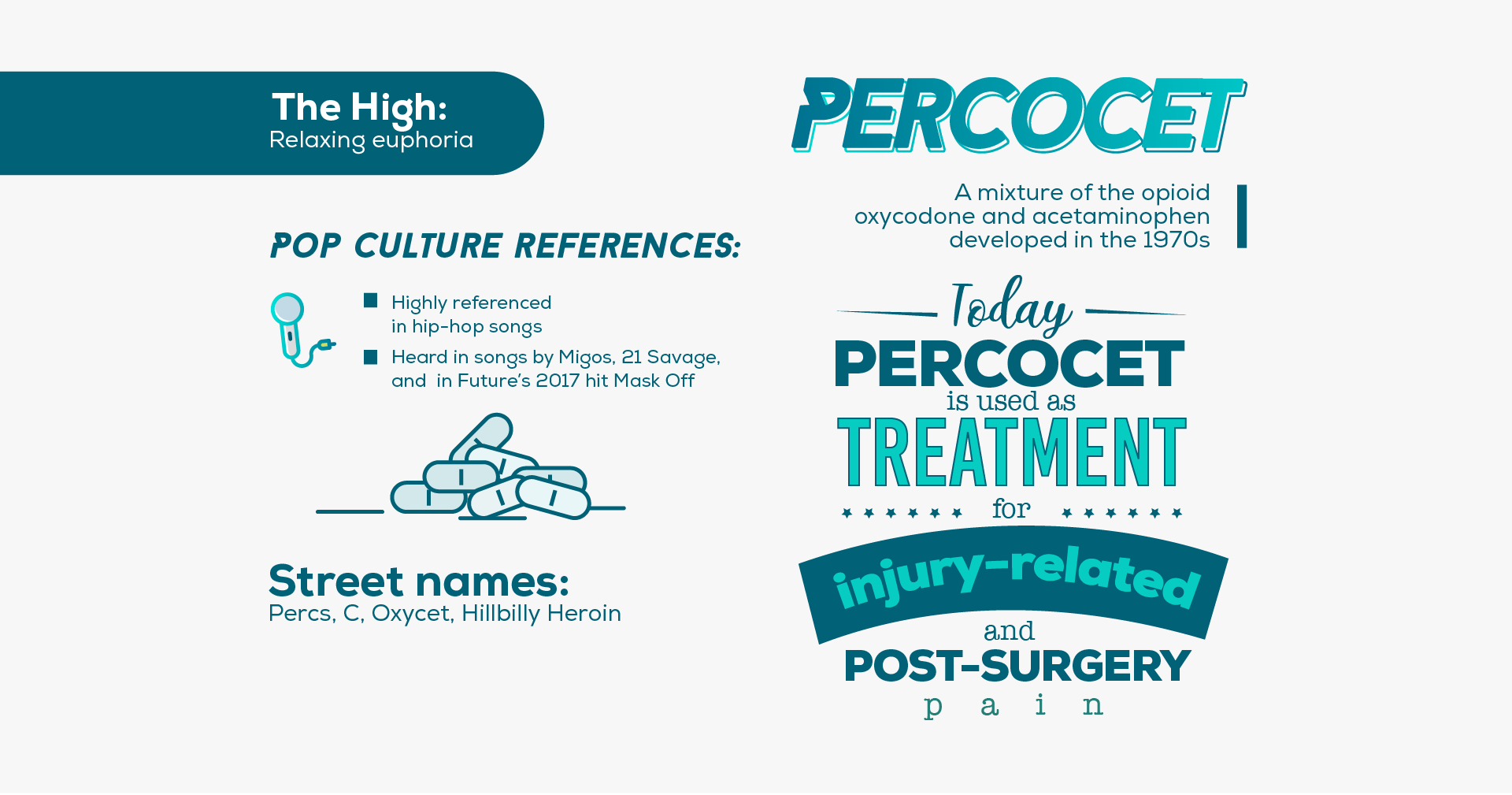
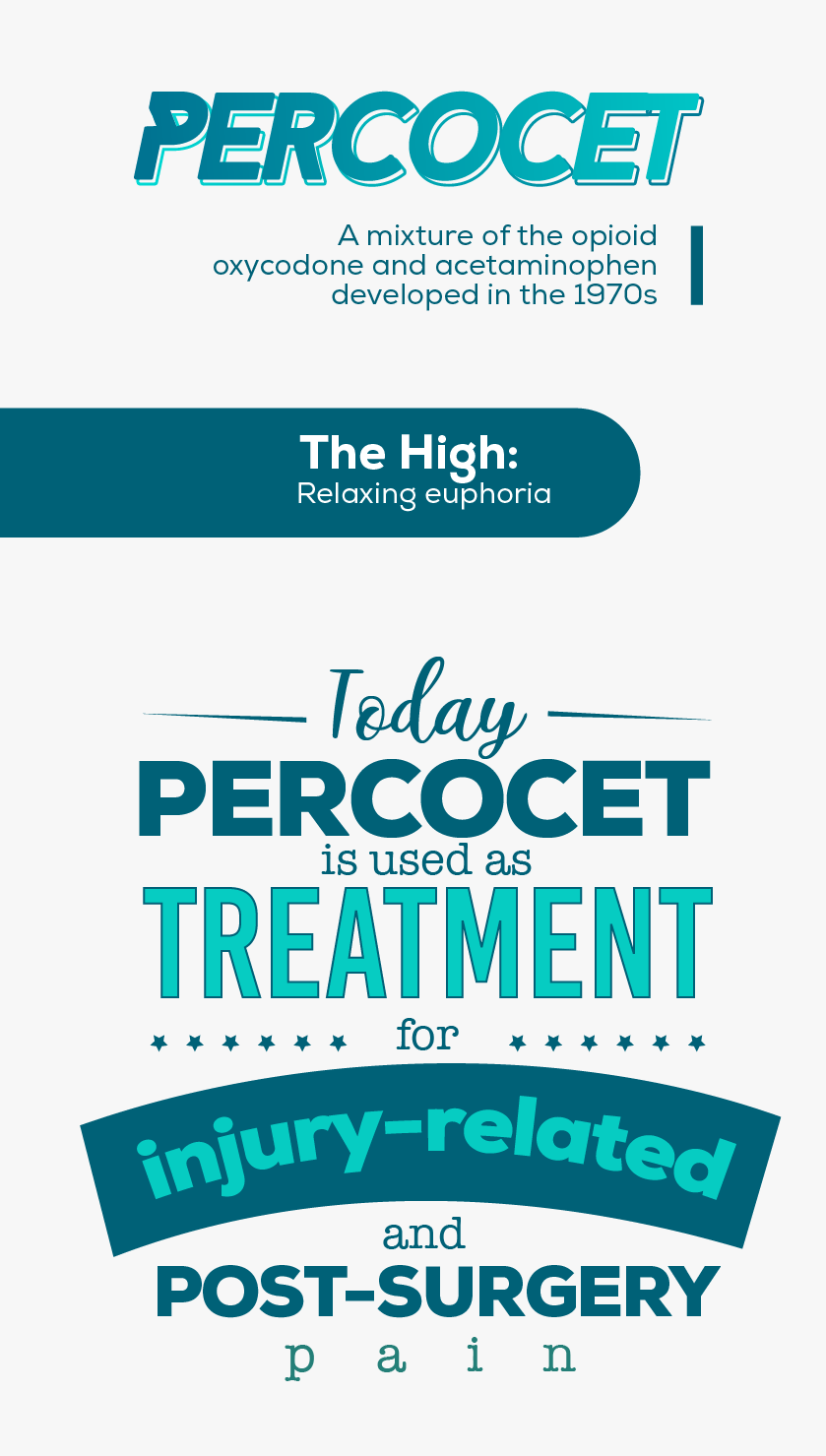
Today, Percocet is still used as treatment for injury-related and post-surgery pain, but its appeal to opioid abusers makes it popular on the black market alongside Oxycontin and Vicodin.
Cultural influences: The major influence of prescription opioids on American culture has been their incredible ability to bring drug addiction to middle class America. Since opioids began being regularly prescribed for chronic pain and other complaints, middle class professionals and housewives are suddenly finding themselves in the throes of addiction. It is not unheard-of for prescription opioid addiction to lead to heroin dependence, once the prescription runs dry.
In 2011, the leading cause of accidental death was listed as drug overdose for the first time in history. This is due to the opioid epidemic, which seems to be affecting people from all walks of life, every social circle, and every race. Of course, pop culture does not always take facts like these into account. Percocet is one of several opioids that has a prominent place in pop culture.
Pop culture references: Hip-hop artists are the most outspoken about the use of Percocet; references to the drug have been heard in songs by Migos, 21 Savage, and Future. If one listens to their opiate-influenced songs though, the mumbling lyrics and over-synthesized beats may not prove complementary the effects of Percocet. Despite the questionable caliber of this subgenre of music, fans took to Future's multiple mentions of "percocet molly percocet" in the song "Mask Off", briefly bringing this combination of drugs into popularity among young listeners.
Even Eminem has rapped about his love affair with Percocet, although his lyrics bring a big dose of regret since his recovery from addiction:
"If I could rewind time like a tape / Inside a boombox, one day for every pill or Percocet that I ate / Cut down on the Valium, I'da heard everything / But death is turning, so definite, wait!" --"Arose", Eminem
Street names: Oxy, OC, OX, Kickers, Blues.
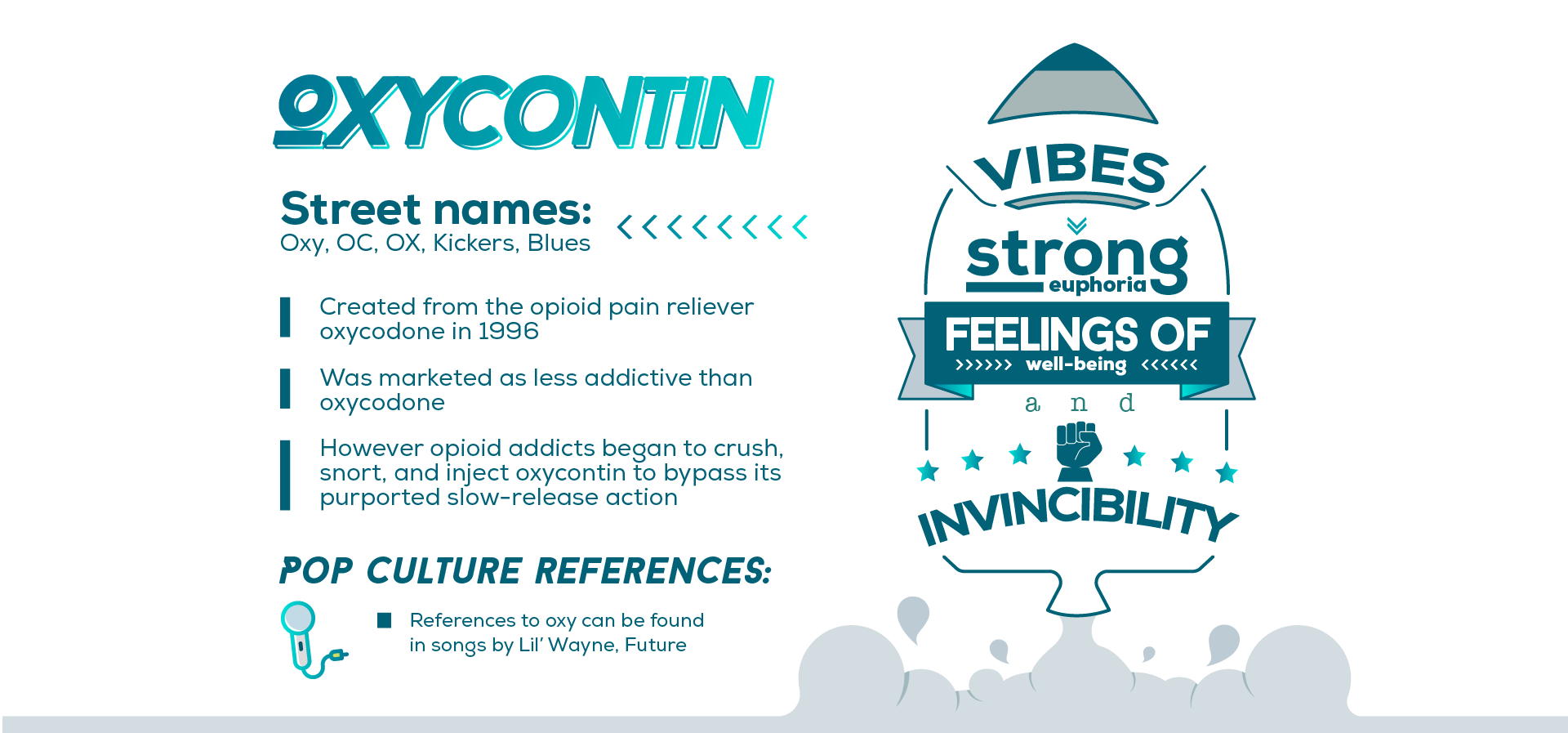
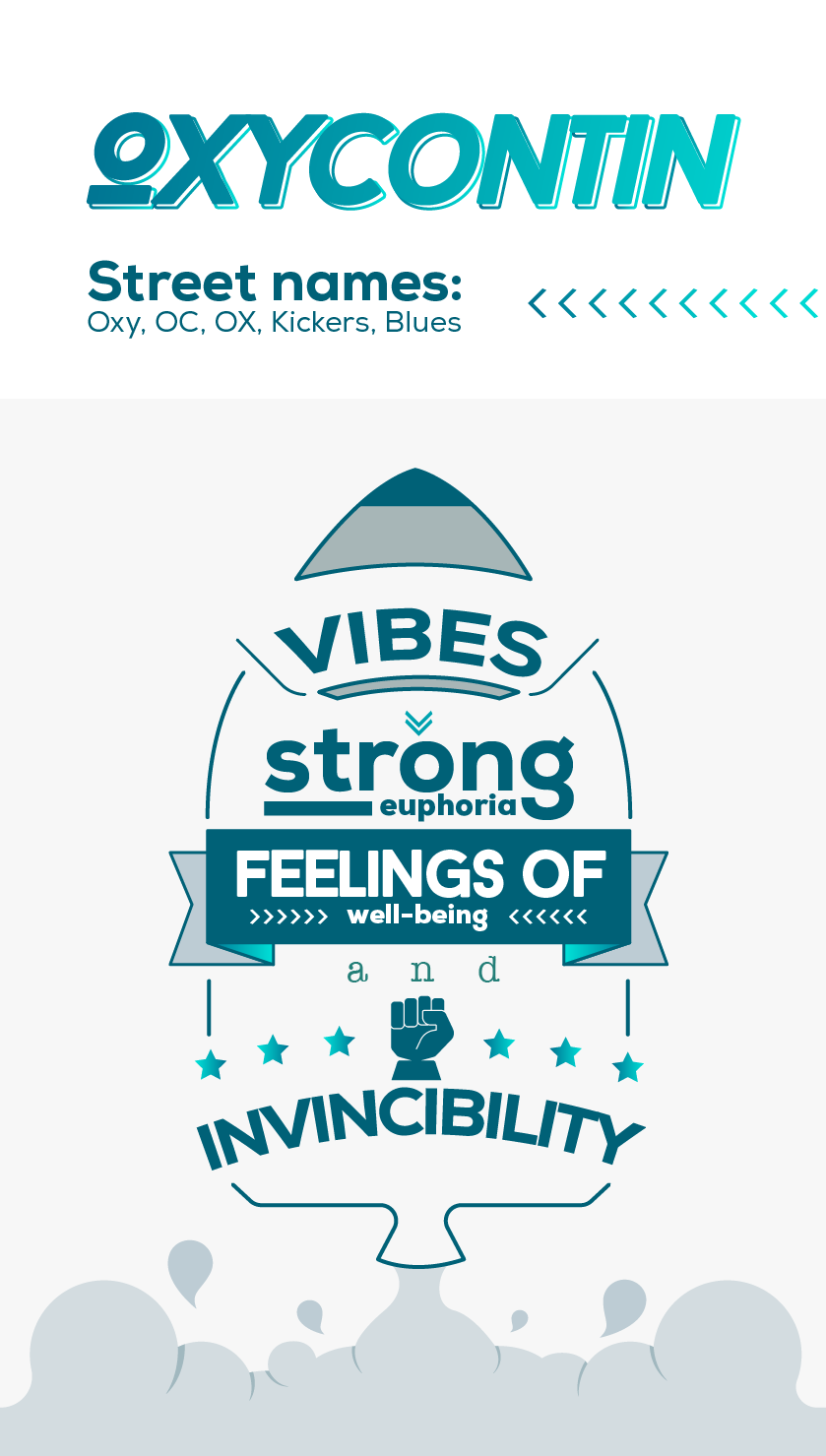
History: Oxycontin was created from the opioid pain reliever oxycodone in 1996. The manufacturer Purdue Pharma marketed the medication as less addictive because its slow-release formula helped to block the euphoric effects of the opioids. Because it was marketed as a solution for chronic pain, doctors everywhere began to prescribe it for chronic pain and injuries, believing it to be the less addictive choice. Needless to say, they were wrong.
By the early 2000s, its potential for abuse was realized by everyone as opioid addicts began to crush, snort, and inject oxycontin, bypassing its purported slow-release action. Purdue Pharma ignored the implications and continued to market the drug aggressively to both doctors and end consumers. By the time doctors and government officials became widely aware of the problem, millions of people across the country were addicted to Oxy.
Cultural influences: The major cultural influence of Oxycontin would be, of course, the current opioid epidemic. While the entire epidemic cannot be laid at the feet of Purdue Pharma, their marketing tactics certainly had a part in it. From the moment the drug was approved for sale, it was marketed to doctors as a perfect solution for chronic pain management, a less addictive and long-lasting alternative to other opioids. In thousands of workshops, trade shows, resort-based lectures, and advertisements, doctors were convinced that Oxy was the answer; they began prescribing it liberally for all types of aches and pains.
Purdue Pharma continued to spend millions marketing Oxy as a "less addictive opioid" even as they were peppered with class-action suits from the victims who had unwittingly succumbed to oxy addiction. People who were prescribed the drug for post-surgery pain or chronic pain were finding themselves addicted, sometimes turning to the black market to buy opioids or heroin when their prescriptions ran out. Just like that, the opioid epidemic was born.
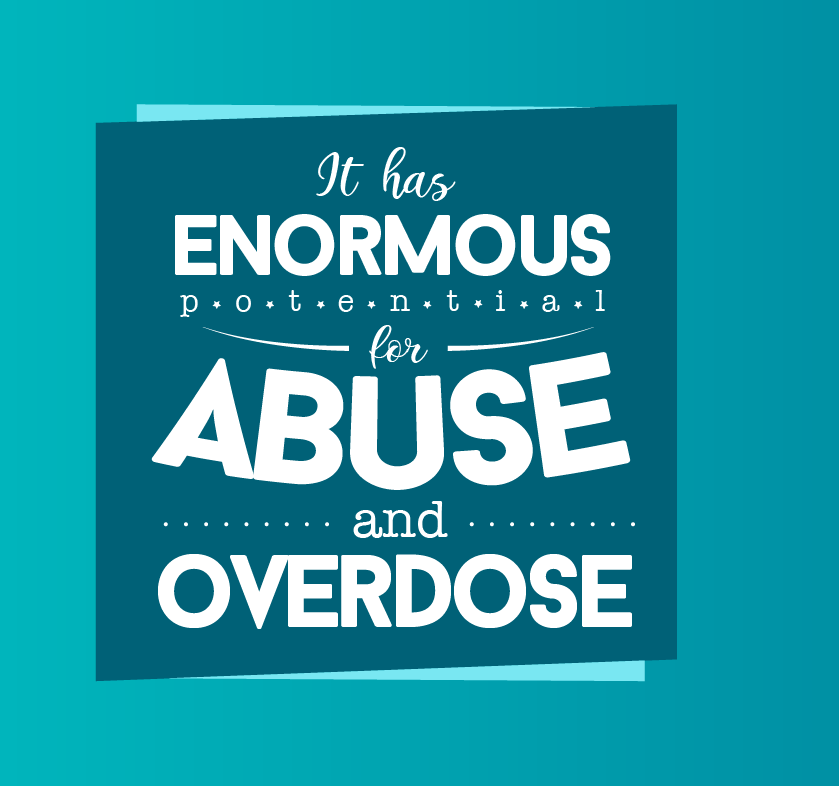
Pop culture references: Oxycontin has made plenty of passing appearances in TV and films since it reached popularity among recreational drug users; sometimes it is used as a humorous reference to poke fun at drug abusers, such as in the the movie This is 40, in which this conversation unfolds:
DEBBIE: "You babysat my kids while you were on Oxycontin."
JODI: "Oxycotton."
DEBBIE: "Oxyconton?"
JODI: "Oxykitten."
DEBBIE: "What's oxykitten?"
JODI: "Meow."
The hip-hop industry will never let a popular illicit drug pass it by, so you'll find your references to oxy in songs by Lil' Wayne, Future, and other hard-partying artists. One of the more surprising references was a song called "Drug Dealer" by Macklemore that calls out the government and pharmaceutical industry for helping to cause the opioid crisis.
"My drug dealer was a doctor, doctor / Had the plug from Big Pharma, Pharma / I think he trying to kill me, kill me / He tried to kill me for a dollar, dollar" --"Drug Dealer", Macklemore
Street names: Fent, Apache, China Girl.
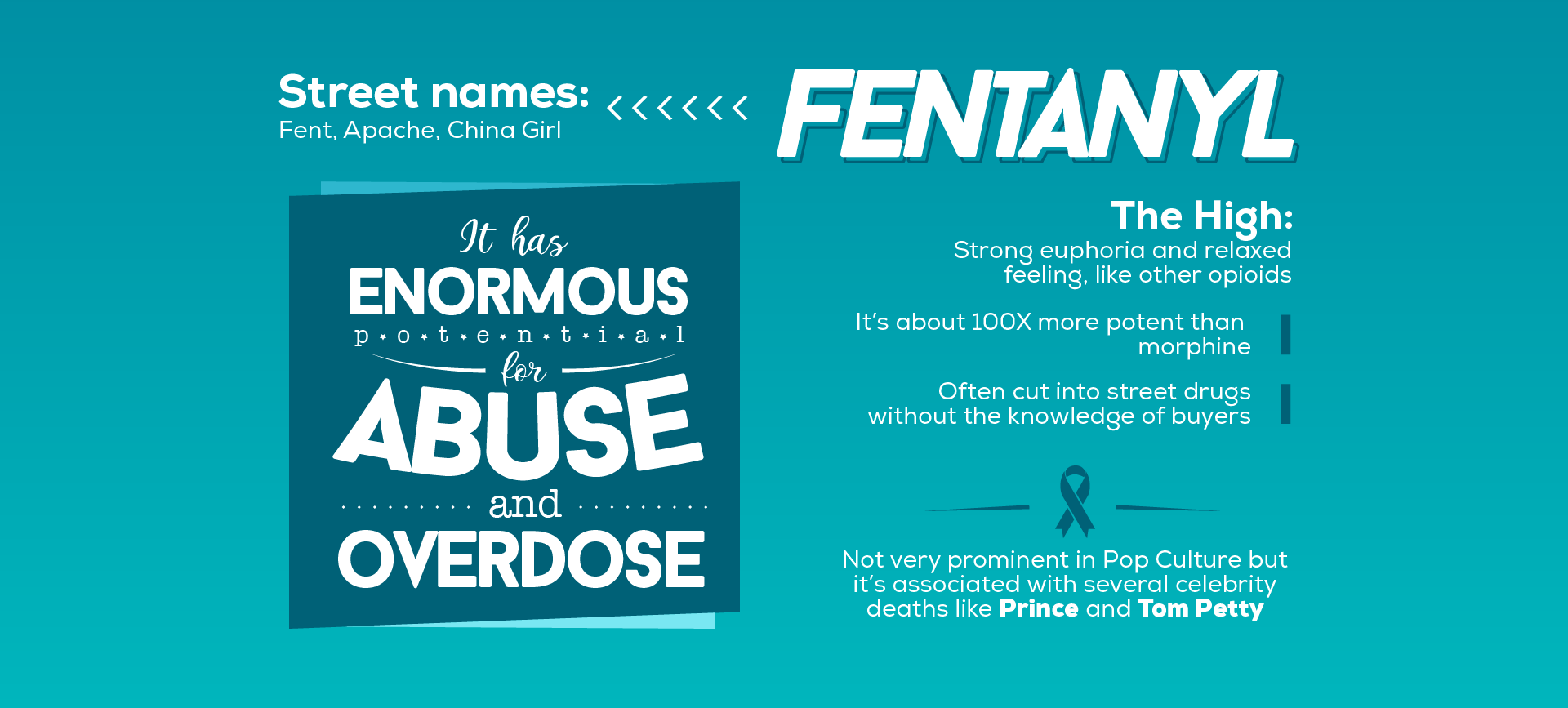
History: When the synthetic opioid Fentanyl was first approved for medical use in 1968, the medical community was well aware of its risks. At around 100 times the potency of morphine, this particular opioid has enormous potential for abuse and overdose. For years, it was only administered intravenously in hospitals, and after that it was offered as a slow-release patch for chronic pain. While manufacturers tried to keep the drug well-controlled, the patent expired in 1981 and eventually, illicit drug labs learned how to synthesize Fentanyl for sale on the black market.
Since then, Fentanyl has been widely sold on the streets and used to cut other drugs, like heroin, causing an alarming rash of overdoses. In recent years, fentanyl has been responsible for more overdose deaths than any other drug.
Cultural influences: While fentanyl hasn't had a significant cultural impact in and of itself, the drug is quickly becoming known as a deadly undertaking, since it has been associated with several celebrity deaths. Both Prince and Tom Petty died in recent years from Fentanyl overdose, and the public has become more aware of the drug and its dangers.
Perhaps the most dangerous aspect of Fentanyl is that it is often cut into street drugs without the knowledge of buyers, greatly increasing the chances of unintentional overdose. Although there is no ready solution in sight, recreational drug users are certainly putting more thought into their sources.
Pop culture references: Fentanyl is not as popular as its other opioid counterparts in pop culture, perhaps because of its deadly nature. Some movies, like Playing God and Another Happy Day, mention its use, but overall it is not a drug that anyone wants to take lightly.
Even hip-hop artists avoid fentanyl it would seem, as there are very few songs that mention the drug at all. When it is mentioned, there is usually a negative connotation attached.
"Is you with me or against me? / I'm a OG now so you need me / Think you poppin' Xanax bars, but it's Fentanyl / (No-no bars, it's Fentanyl) / Think you're living life like rockstars but you're dead now" --Big Bro, Quavo
Street names: Xannies, Zanbars, Footballs.
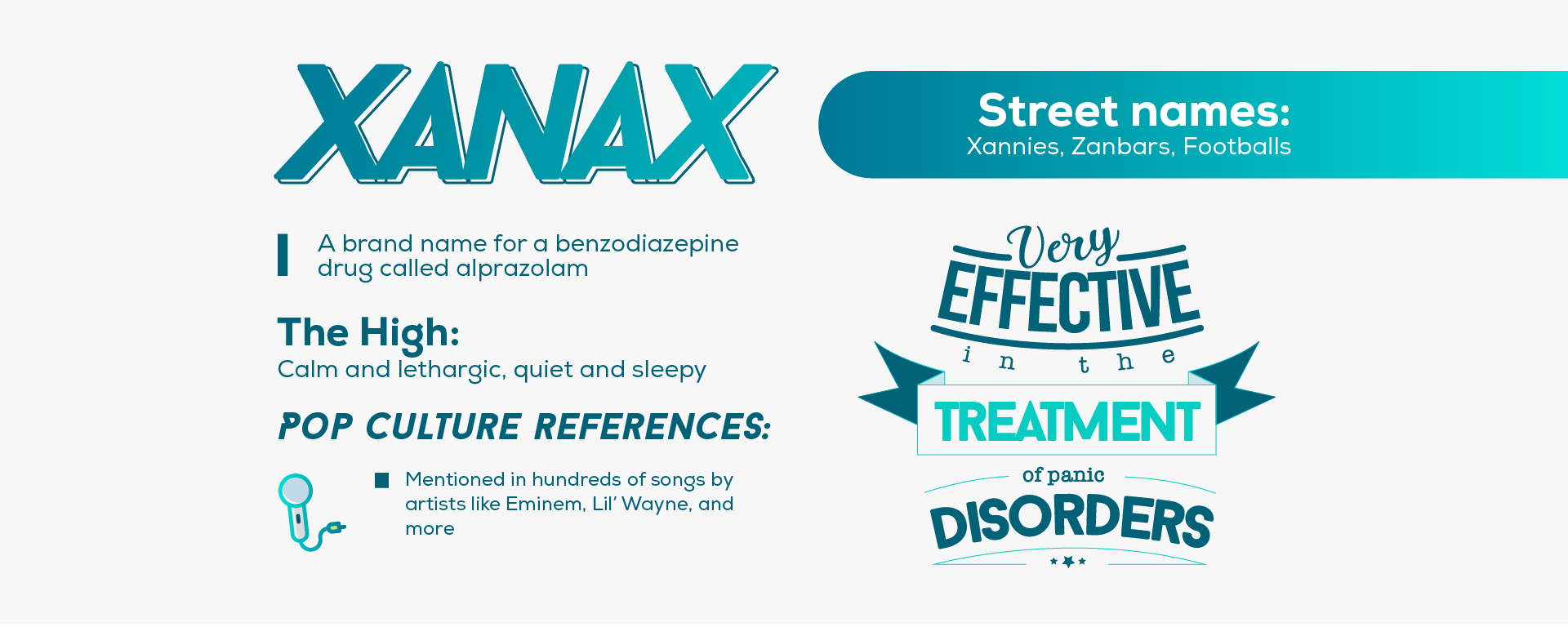
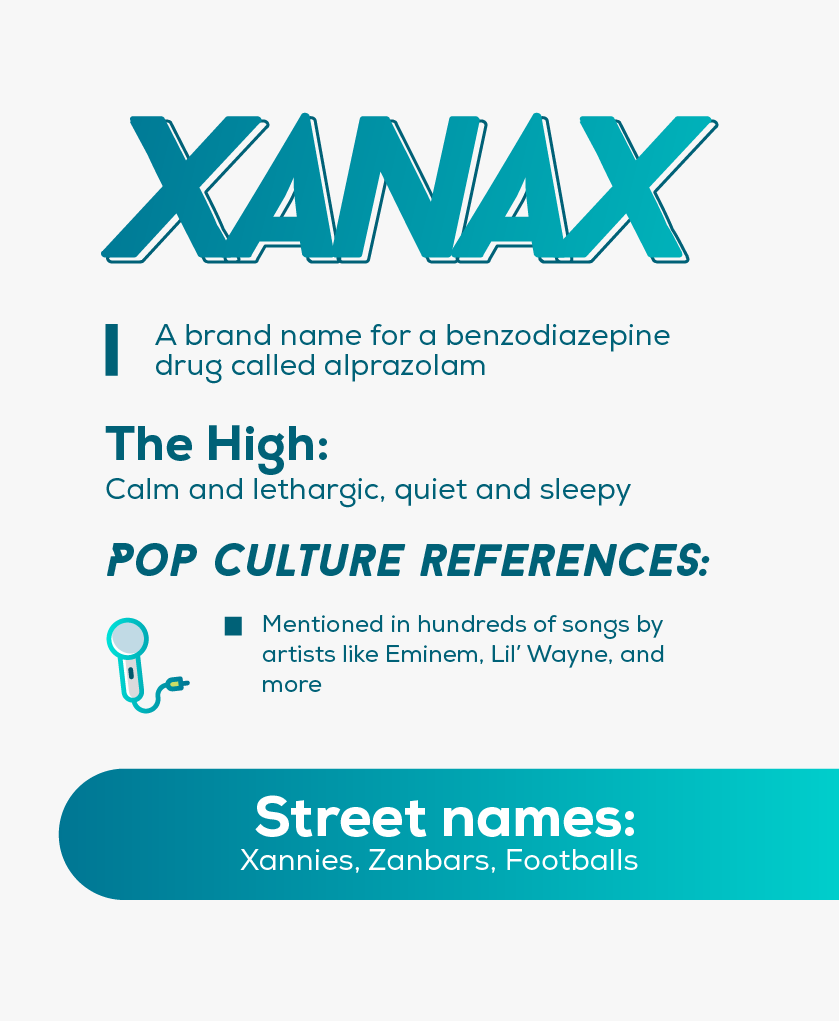
History: Xanax is the brand name for a drug called alprazolam that was developed in the late 1970s as a tranquilizer for extremely anxious patients and panic disorders. The medication is more effective than other benzodiazepines for the treatment of panic disorders, making a good alternative to the less-potent Valium. It is more addictive than most other benzos however, which is evident in pop culture today.
Cultural influences: Benzos like Xanax were part of a disastrous trend throughout the late 20th century for doctors and psychiatrists to throw tranquilizers at any type of anxiety or mental disorder. Although Xanax was marketed as a "less addictive" type of benzo, this proved false marketing by the pharmaceutical industry, once again. As the drug became more popular for recreational use, to mix with other drugs, or to treat come-downs off of uppers, Xanax somehow permeated music culture to the point of no return.
Now, Xanax is so popular among hip-hop artists and similar genres that it supposedly has its own sound, referred to as 'pill-pop'.
Pop culture references: While Xanax has made plenty of appearances in books, movies, and TV shows, it is music that has really taken this particular drug under its wing. The drug has permeated hip-hop culture especially and is mentioned in hundreds of songs by artists like Eminem, Lil' Wayne, Three 6 Mafia, Danny Brown, and the now-deceased Lil' Peep.
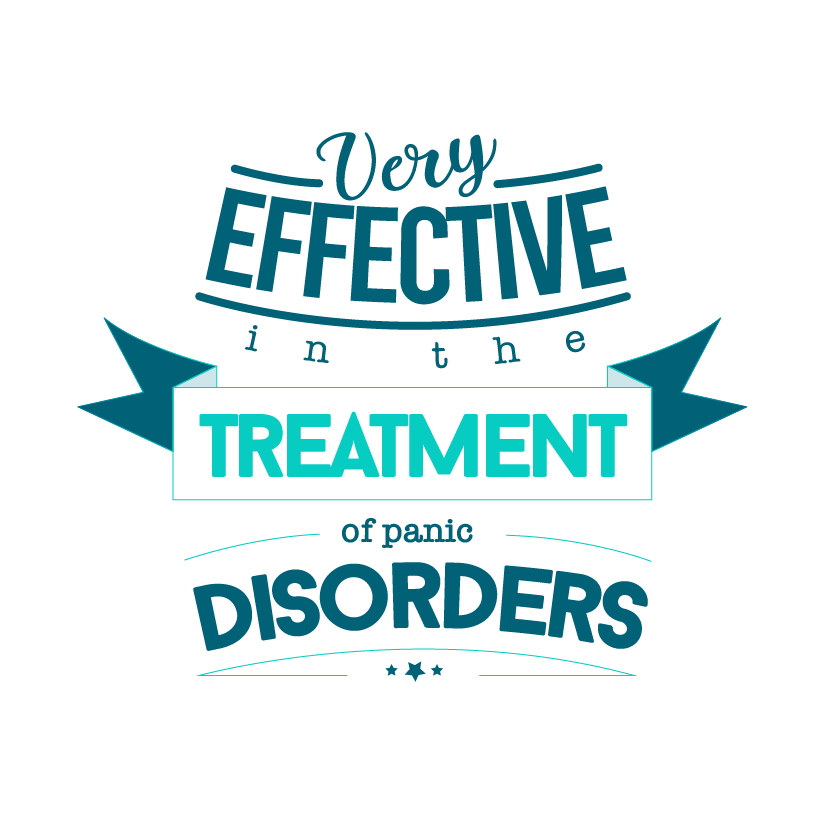
Beyond its musical connotations, benzos have also been famously present in the various substance cocktails that lead to the deaths of Amy Winehouse, Brittany Murphy, Whitney Houston, and Heath Ledger. Strangely, this association has not seemed to dampen the popularity of Xanax in pop culture.
"Grimy n***a way too groovy for the Grammys / Overseas collecting panties, poppin' Xannies..." -- "B*tches N Marijuana", Chris Brown & Tyga
Street names: V, Yellow V, Tranks.
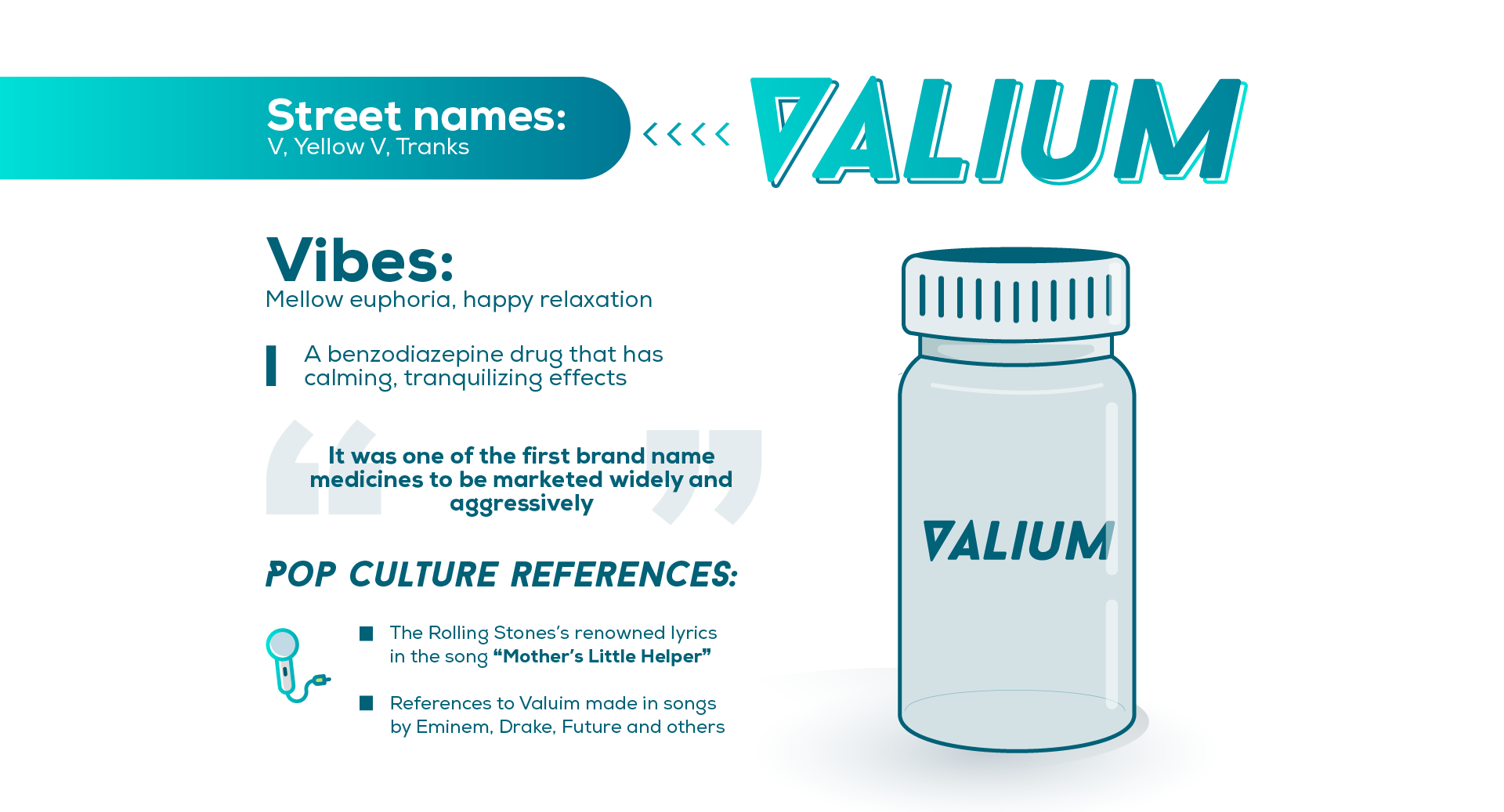
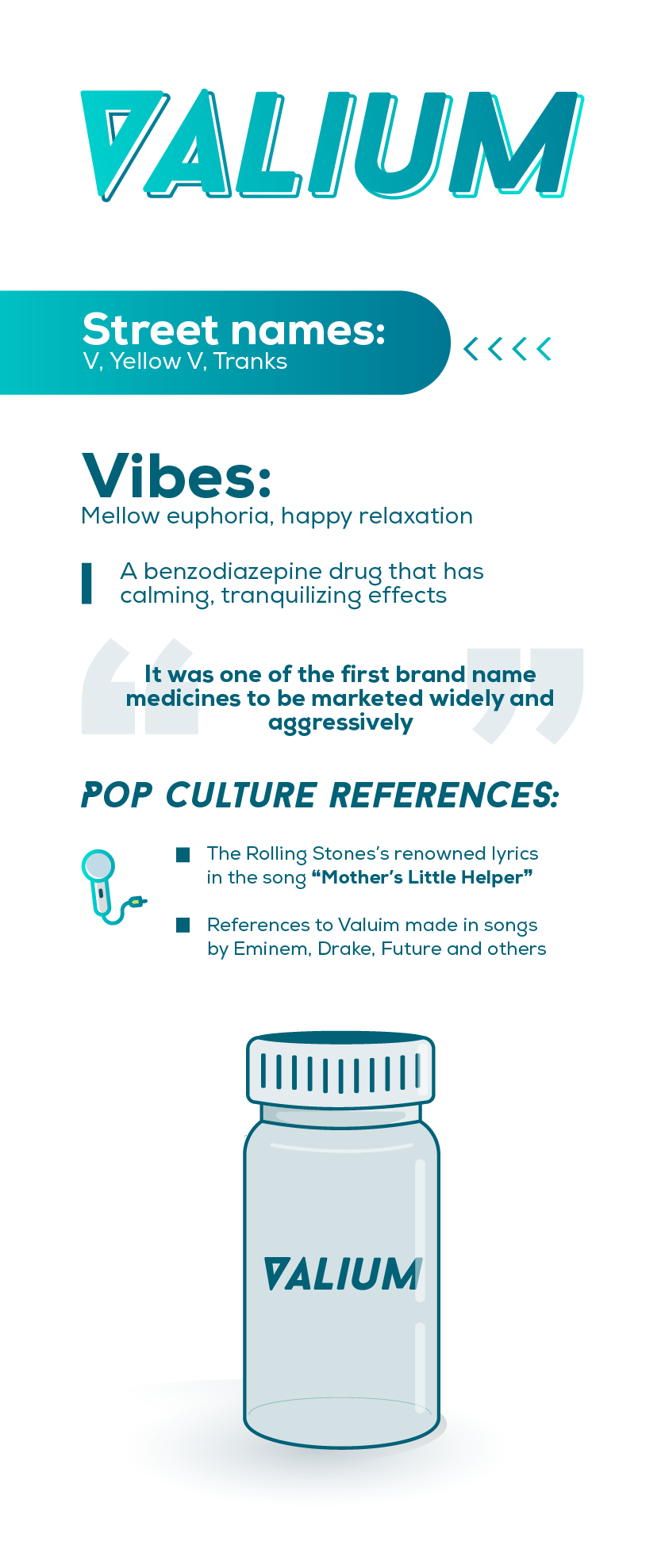
History: Valium, like Xanax, is a benzodiazepine drug that has calming, tranquilizing effects. It was invented by a Swiss pharmaceutical company in 1969 and quickly caught on as an anti-anxiety medication. Valium was one of the first brand name medicines to be marketed widely and aggressively, turning it into one of the most widely prescribed drugs of all time between 1969 and 1982.
Doctors prescribed the drug to any and all patients that reported symptoms of anxiety, making it wildly popular among lonely and overburdened housewives. So common was this occurrence that even First Lady Betty Ford became famously addicted to Valium while she was living in the White House; the medication had been prescribed by her doctor to calm her nerves.
Doctors and the public in general are now aware of the addictive qualities of Valium and it is prescribed much more carefully. It is still a popular tranquilizer on the streets however, and remains one of the most abused prescription drugs.
Cultural influences: Valium's wild success as a brand name drug set a precedent in the pharmaceutical industry. Its almost instantaneous infiltration into the average American household showed pharmaceutical companies that if they marketed their drugs to the right doctors in the right way, prescriptions and revenues would follow. Other drug manufacturers followed suit with medications like Xanax and Percocet, and the implications are clear. Valium was the beginning of a movement that brought psychotropic and addictive prescription drugs into mainstream society.
Pop culture references: By far the most relevant Valium reference to date would the Rolling Stones's renowned lyrics in the song "Mother's Little Helper":
"What a drag it is getting old / 'Kids are different today,' I hear ev'ry mother say / Mother needs something today to calm her down / And though she's not really ill / There's a little yellow pill / She goes running for the shelter of a mother's little helper." --"Mother's Little Helper", The Rolling Stones
Pop culture references to Valium were commonplace during its '70s peak period, with comedic references made to the drug's prevalence. In the 1979 movie Starting Over, Burt Reynolds's character had a panic attack. When his brother asked, "Does anybody have a Valium?", every woman in the store opened her purse.
Musical references continued during the '90s and right on through until today, such as the Verve Pipe's "The Freshmen", in which an ex-girlfriend overdoses on Valium, or several more modern references to Valium in songs by Future and Drake. Valium was also one of Eminem's favorite prescription vices, so he included it many songs, both pre and post recovery.
"My mom loved Valium and lots of drugs / That's why I am like I am 'cause I'm like her / Because my mom loved Valium and lots of drugs / That's why I'm on what I'm on 'cause I'm my mom" --"My Mom", Eminem
Street names: Acid, Doses, Lucy.
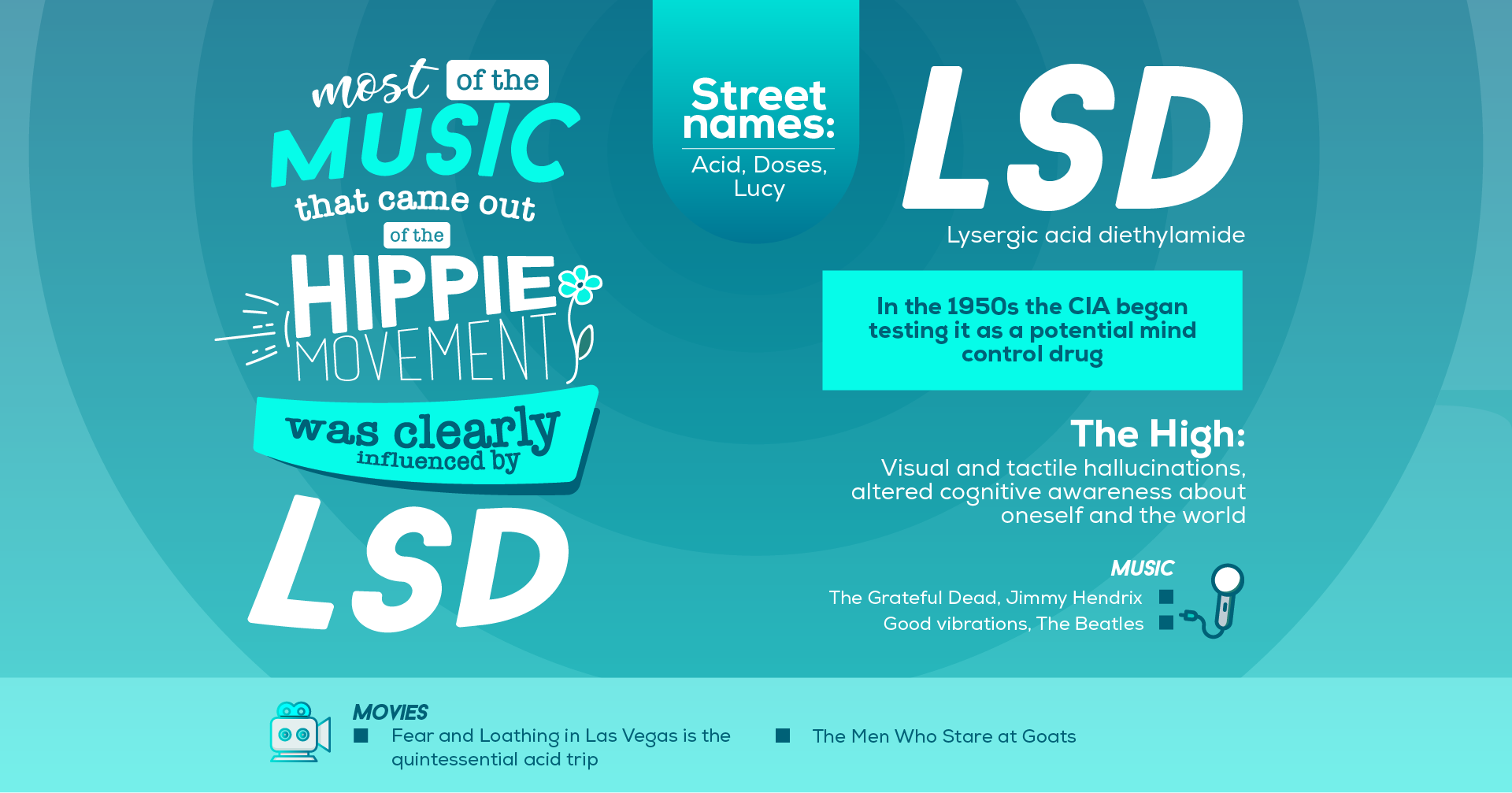
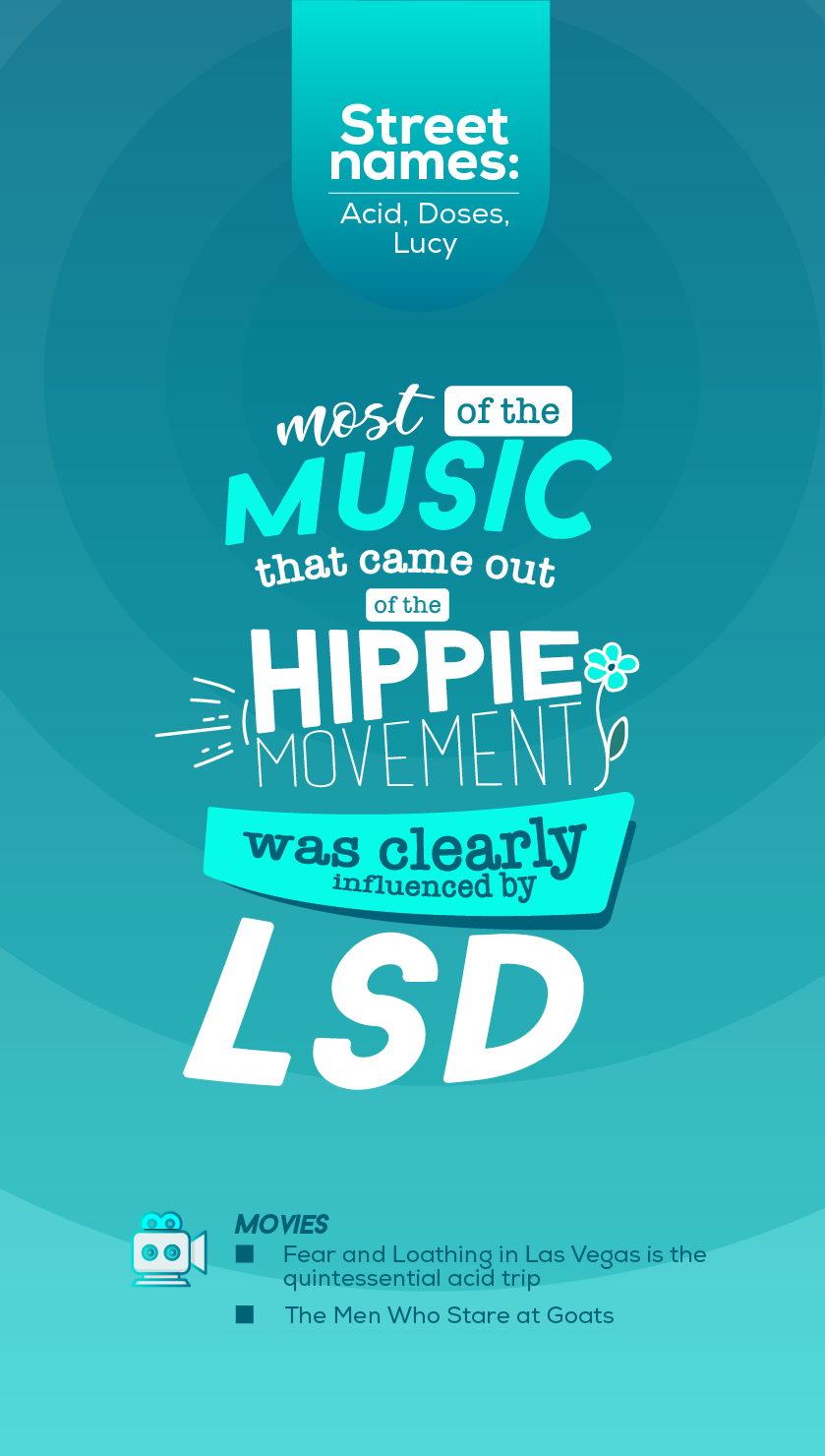
History: LSD was developed in 1938 by a Swiss chemical company, but it was not used in any real sense until the1950s when the CIA began testing it as a potential mind control drug. One participant of this program, Ken Kesey, was so impressed by his experience that he introduced it to his friends as a recreational drug. The group began hosting parties in San Francisco where attendees tripped on LSD and listened to live music by bands like the Grateful Dead. The parties were called 'Acid Tests' and spurred a movement in San Francisco that would soon become an integral part of the hippie revolution.
At about the same time, intellectuals at Harvard and other prestigious scientific programs were testing the drug on student participants to study its effects. The simultaneous influences of the Harvard experiments and Acid Test parties brought LSD into the spotlight; the world would never be the same.
Cultural influences: LSD's cultural influence is apparent in almost every aspect of the hippie movement. The pink and orange swirls painted on VW vans replicated the strange textures and colors that can register during an acid trip. The psychedelic music produced by artists like The Grateful Dead, Jimmy Hendrix, and the Beatles all reflects the 'good vibrations' brought on by intense acid trips. Even books and literature that came out of this time period, like The Electric Kool-Aid Acid Test by Tom Wolfe, were clearly influenced by LSD experiences. Would the hippie revolution have been the same without LSD? It's doubtful.
Pop culture references: During the 1960s and '70s, hundreds of books were written about LSD and the psychedelic experience, while most of the music that came out of the hippie movement was clearly influenced by (and possibly recorded on) LSD. There are plenty more recent pop culture references to the drug, however. Johnny Depp's performance in Fear and Loathing in Las Vegas is the quintessential acid trip, for example; and the movie The Men Who Stare at Goats was based on the military's attempts to use LSD as a mind control drug.
RAOUL DUKE: "Oh god... did you eat all this acid?"
DR. GONZO: That's right. MUSIC!
-- Fear and Loathing in Las Vegas
Street names: DET, AMT, Businessman's Trip, Fantasia.

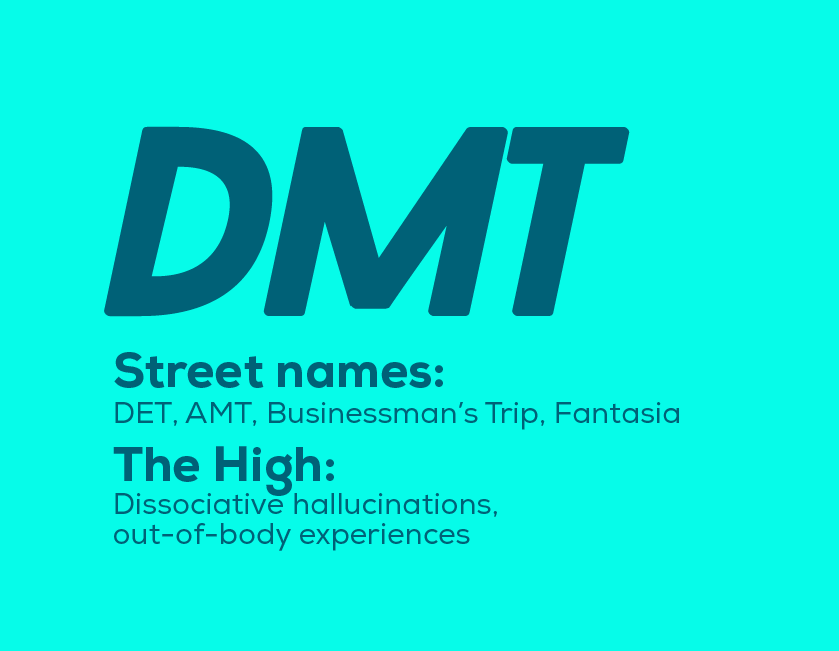
History: DMT is synthesized from a certain type of tree bark that only grows in the Amazonian rainforest. Although this plant has been used as a tribal hallucinogen for thousands of years, it wasn't synthesized into modern-day DMT until 1956. Even during the psychedelics craze of the 1960s and '70s, DMT never gained much popularity as a recreational drug until the 1990s when Dr. Rick Strassman published a book about his findings after experimenting with the drug. The book was called The Spirit Molecule, and created a great deal of curiosity and controversy around the use of DMT. It then became a popular hallucinogen for recreational drug users who were searching for a spiritual or out-of-body experience.
Cultural influences: DMT is and always has been an obscure, difficult-to-obtain substance, and so its impact on culture at large is not highly significant. Dr. Strassman's studies, findings, and written works, however, have engendered a cult-like following of DMT enthusiasts who hope to find Big Answers to Big Questions through their spiritual DMT experiences.
Pop culture references: This is one substance that does not crop up in pop culture as other more accessible psychedelics, but it does come up now and then. In Enter the Void, characters repeatedly discuss the theory that DMT creates some connection with the afterlife. It is also mentioned in the 2004 western flick Renegade and, more recently, in the Hulu series The Path. For now, it seems that DMT and its users will remain in the shadows of obscurity.
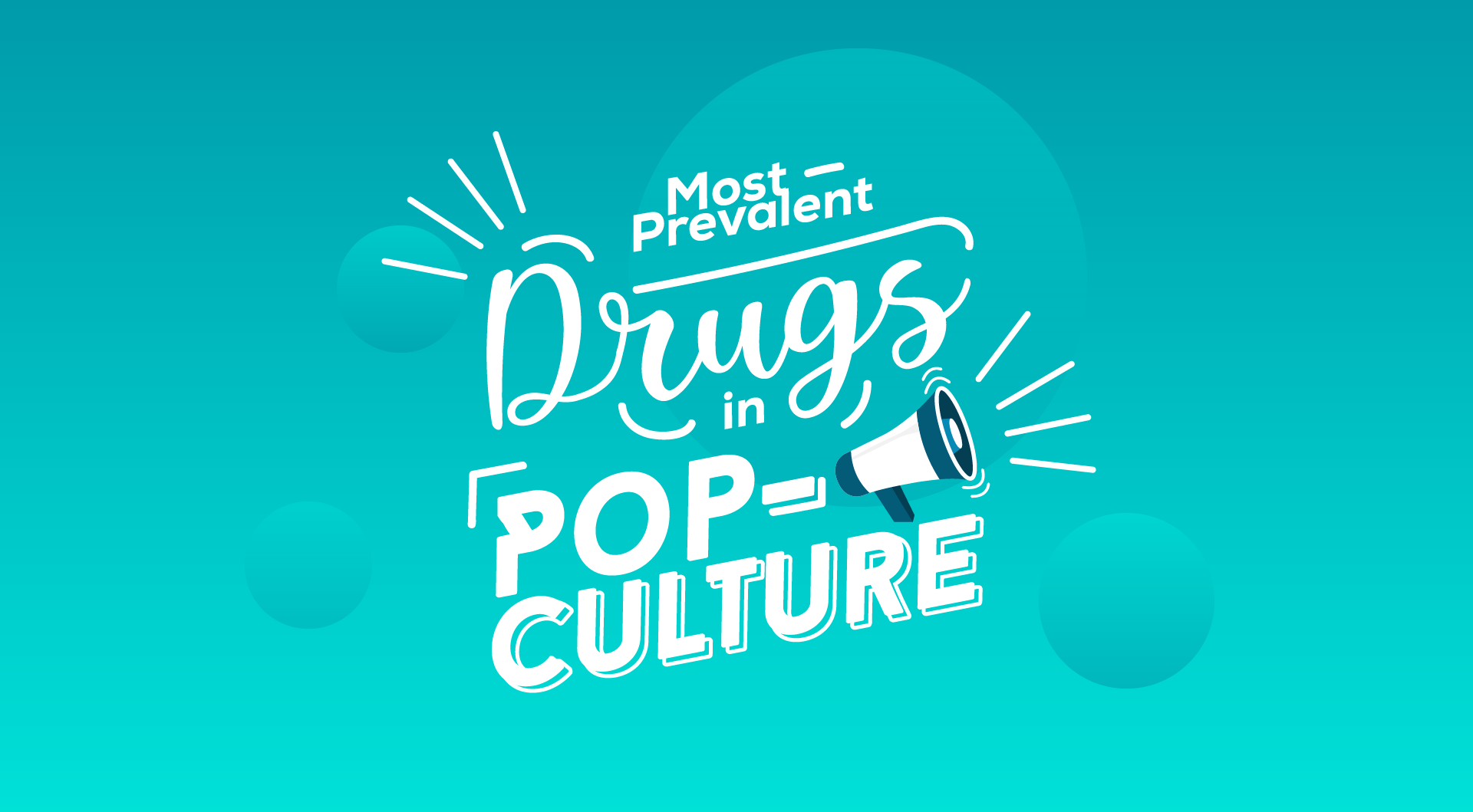
"I thought I had died, and that I might not ever come back. I don't know what happened. All of a sudden, BAM!, there I was. It was the most beautiful thing I've ever seen." ― Rick Strassman, DMT: The Spirit Molecule
Street names: Shrooms, Magic Mushrooms.
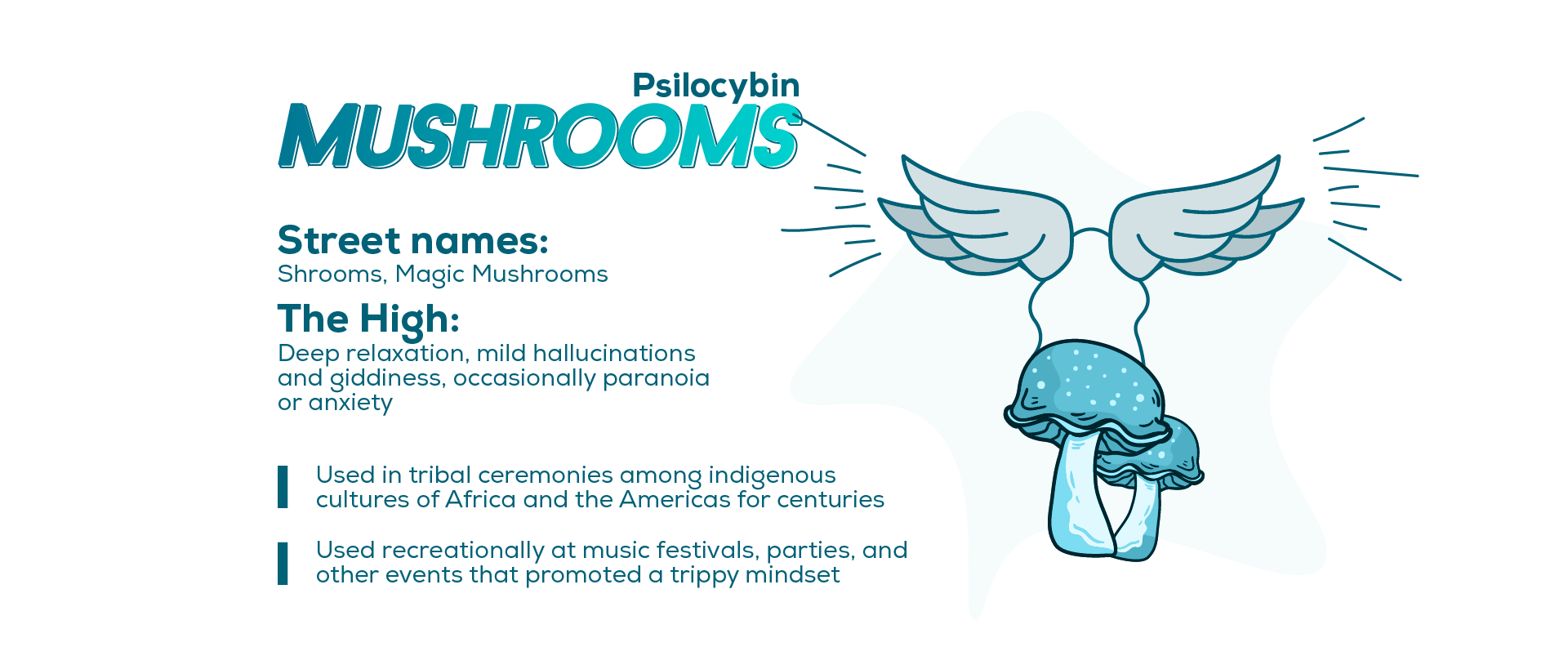
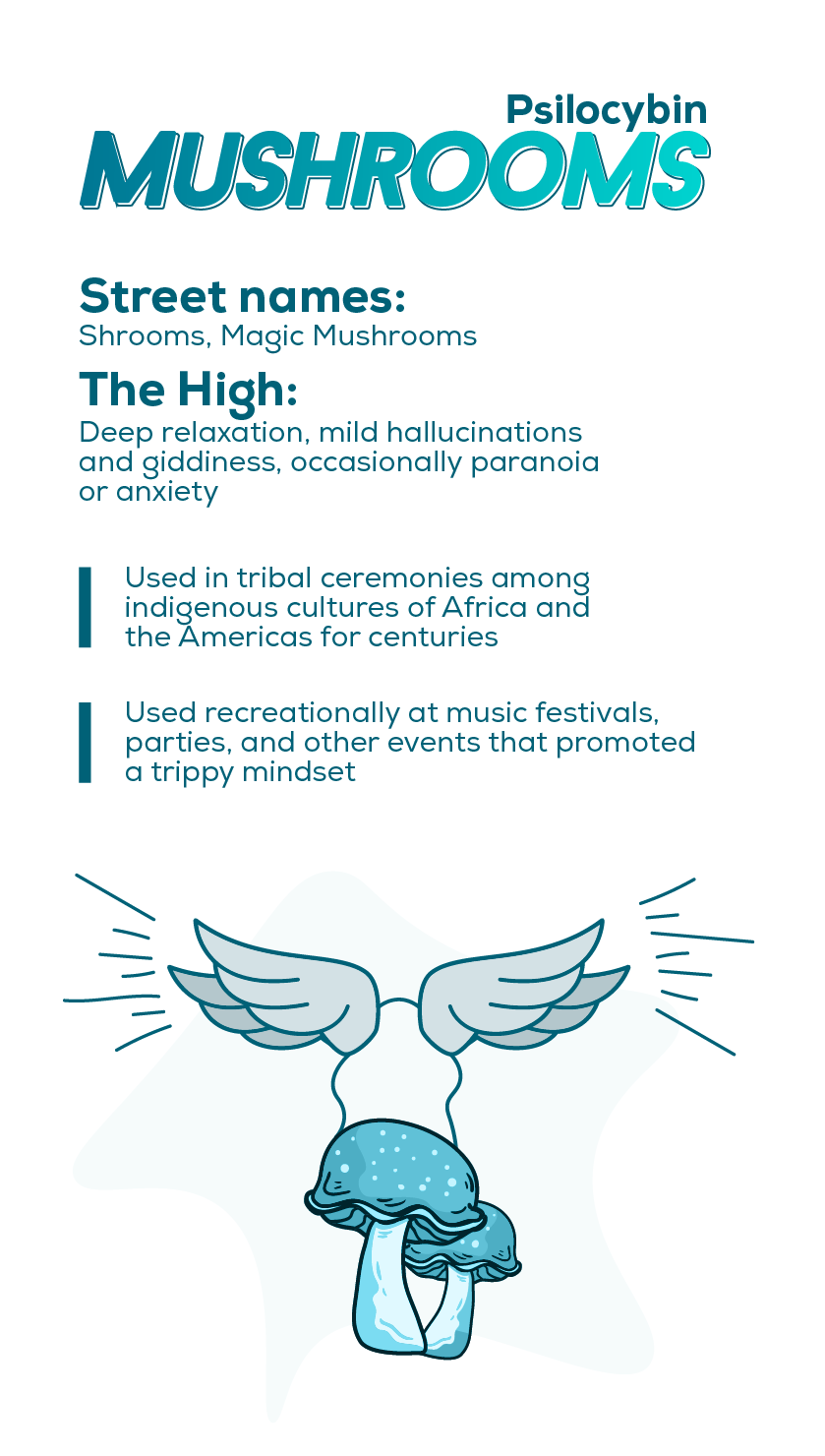
History: Psilocybin mushrooms have been used in tribal ceremonies among indigenous cultures of Africa and the Americas for centuries, if not millenia. It was in southern Mexico, that mycologist R. Gordon Wasson decided to take part in an indigenous mushroom ritual and discovered the unique psychoactive properties of shrooms in 1955.
Wasson went on to write an article about his experience for Life Magazine in 1957; since interest in LSD and other psychoactive drugs were already coming into popularity, shrooms were carried along with the hippie movement and soon became a crowd favorite. The 1970s brought government sanctions for all drugs, including magic mushrooms, but the substance remains popular as a mild psychedelic.
Cultural influences: As an ancient ritual practice, psilocybin mushrooms provided a spiritual or religious experience. When psychedelics gained popularity in mid-20th century America, shrooms became part of the counterculture movement, much in the same way as LSD. They were (and still are) used recreationally at music festivals, parties, and other events that promoted a trippy mindset.
Mushrooms do still have a place in the spiritual realm as well. Various spiritual and scientific studies have been conducted that portray the spiritual influence of the mushroom trip. While there's plenty of spiritual leaders who swear by the effects of the magical mushroom, its spiritual following is decidedly small.
Pop culture references: Shrooms are often used for comic effect in TV and movies, such as in the unforgettable Super Troopers opening scene where Geoffrey Arend eats an entire bag of mushrooms right before getting pulled over by state troopers. Since a mushroom trip can be a giggly, somewhat ridiculous spectacle, it is often used to create ridiculous characters.
Mushrooms also pop up now and then in music. Incubus's first album Fungus Amongus may have been entirely based on mushroom tripping, and several hip-hop artists have referred to the mystical fungus in their lyrics. Self-professed addict Eminem wrote an entire song about his regret about dosing a girl with magic mushrooms and causing her a major freak out.
"You must have eaten, like, a hundred bucks worth of pot, and, like, 30 bucks worth of shrooms man." -- Super Troopers
Vibes: Happy euphoria, lack of inhibition, relaxation.
Street names: Booze, Juice, Sauce, Hooch.
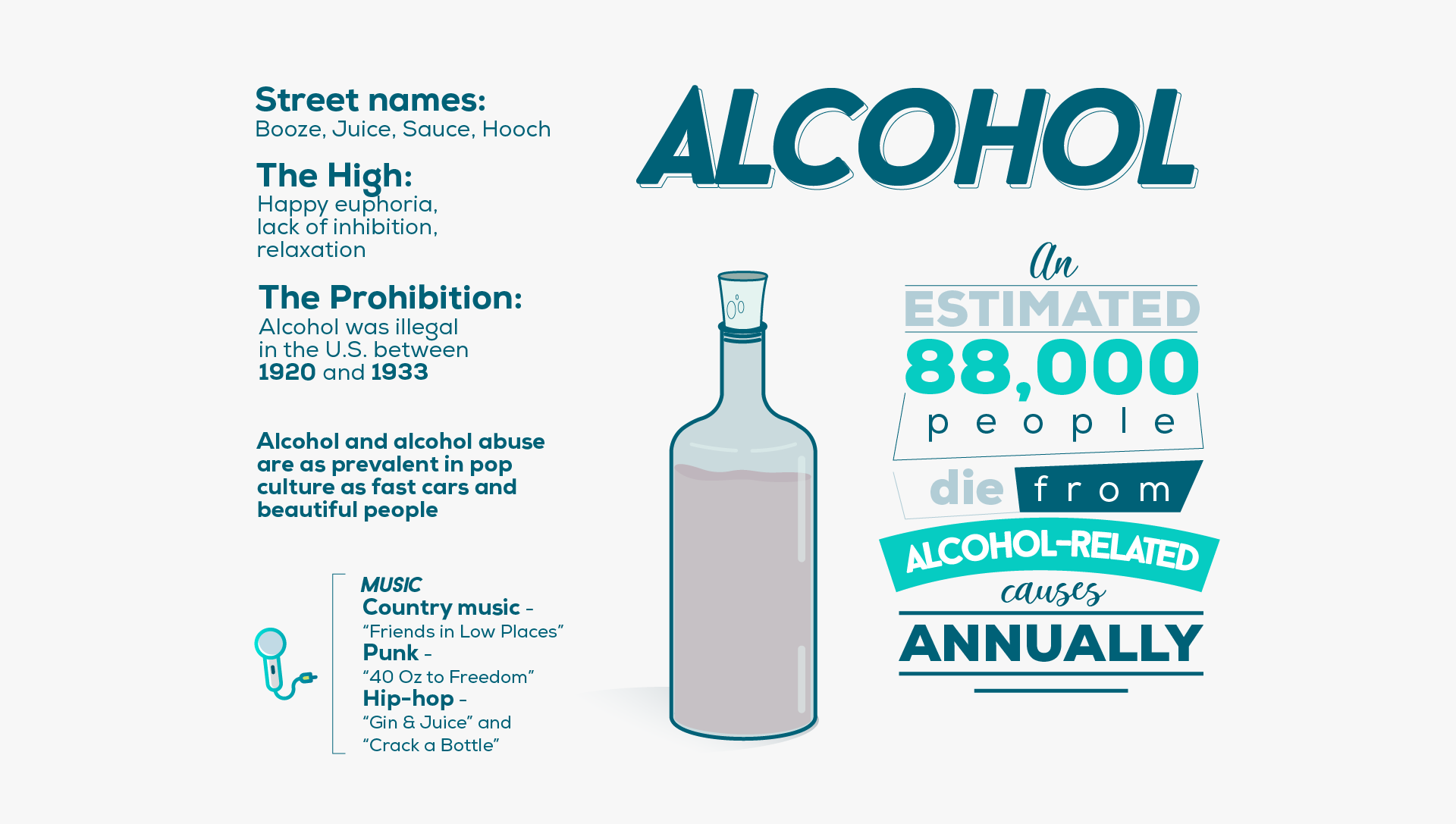
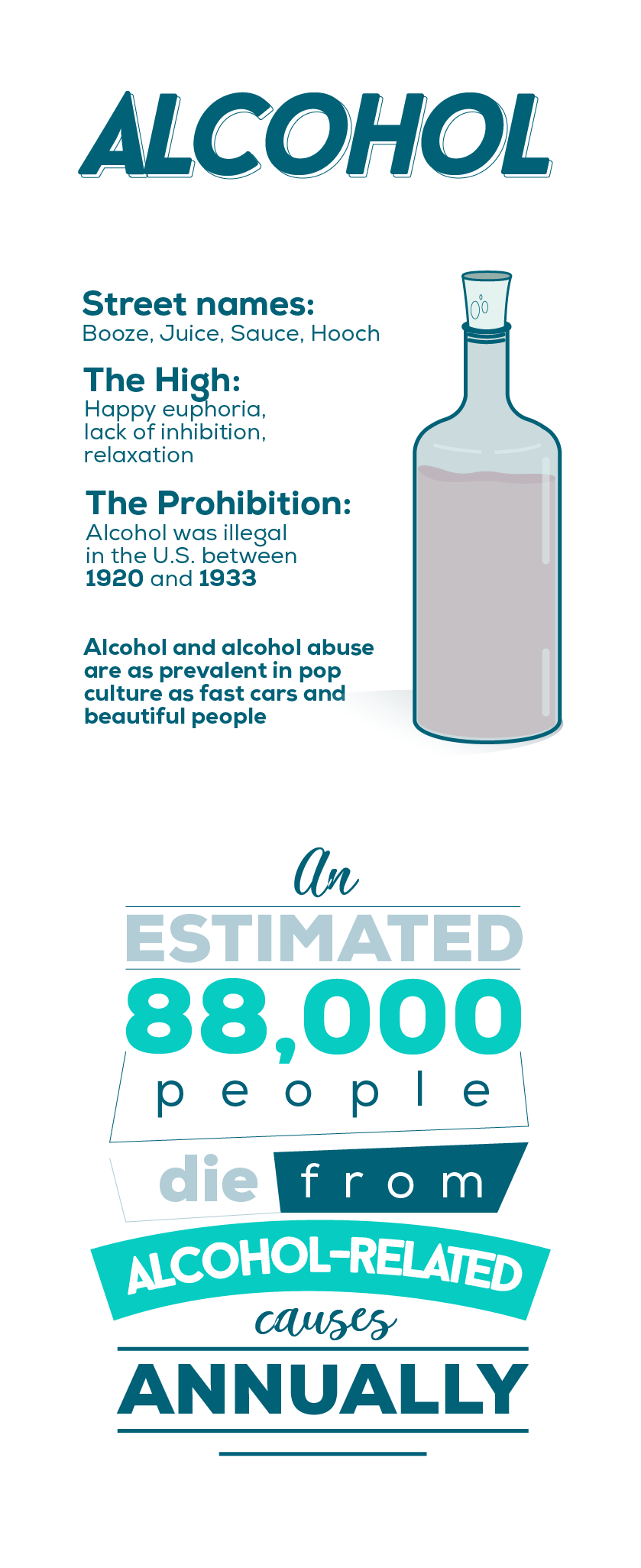
History: In ancient cultures like Egypt and China, the drinking of fermented alcoholic beverages has been recorded as far back as 7,000 BC. Wine was the beverage of choice for many cultures for thousands of years, while hard liquor like gin was not adopted widely until about the 16th century.
In those days, alcohol abuse was common and there were little to no initiatives to reduce public drinking habits until the 20th century, when the temperance movement began. This eventually led to a complete criminalization of alcohol in 1920, when alcohol remained illegal between 1920 and 1933. The illegal booze trade was so prevalent however, that the government decided to end Prohibition again after 13 years. Since then, alcohol abuse has once again spread and an estimated 15 million Americans have alcohol abuse disorders.
Cultural influences: Most cultures on record have noted some forms of intoxication, and alcohol is the most prevalent intoxicant in almost every civilization. Alcohol has become so ingrained in social behaviors, in fact, that different types of alcohol play different roles in society. Champagne is associated with celebrations, while wine is a marker of social status in many societies, and beer is required for casual gatherings or sports-related events. In European-based societies, alcohol has become a marker of gender and social class as well. Straight liquor and beer are supposedly men's drinks, while cocktails and wine are often seen as female beverages.
Pop culture references: Alcohol and alcohol abuse are as prevalent in pop culture as fast cars and beautiful people. The loveable alcoholic is an ongoing theme that never seems to get old; think Homer Simpson, The Big Lebowski, and Charlie Harper.
Even when TV doesn't glorify alcohol, it seems like every TV series has a character that suddenly develops alcohol use disorder, goes to rehab, and becomes instantly and permanently recovered. The Desperate Housewives, Grey's Anatomy, and This is Us are all examples.
And let's not forget music. Is there any genre that hasn't paid tribute to alcohol? Country music has "Friends in Low Places", punk gave us "40 Oz to Freedom" and hip-hop has produced such classics as "Gin & Juice" and "Crack a Bottle".
When it comes to substance use, alcohol is clearly pop culture's favorite poison.
"Here's to alcohol: the cause of, and solution to, all of life's problems." --Homer Simpson
With alcohol and drugs ingrained so deeply in today's popular media, from TV and movies to literature and (most especially) music, it is no wonder that the nation's biggest media consumers - young people - are searching out intoxicants as a form of entertainment and self-medication.
Of course, they aren't the only ones. Substance abuse has perhaps never been more prevalent among adults than it is today. After all, if my favorite singer or sitcom character is popping Xanax and throwing back jello shots, why not me?

Our admissions coordinators are here to help you get started with treatment the right way. They'll verify your health insurance, help set up travel arrangements, and make sure your transition into treatment is smooth and hassle-free.
Contact Us